Reasons
Stuffed Pasta
Vegan
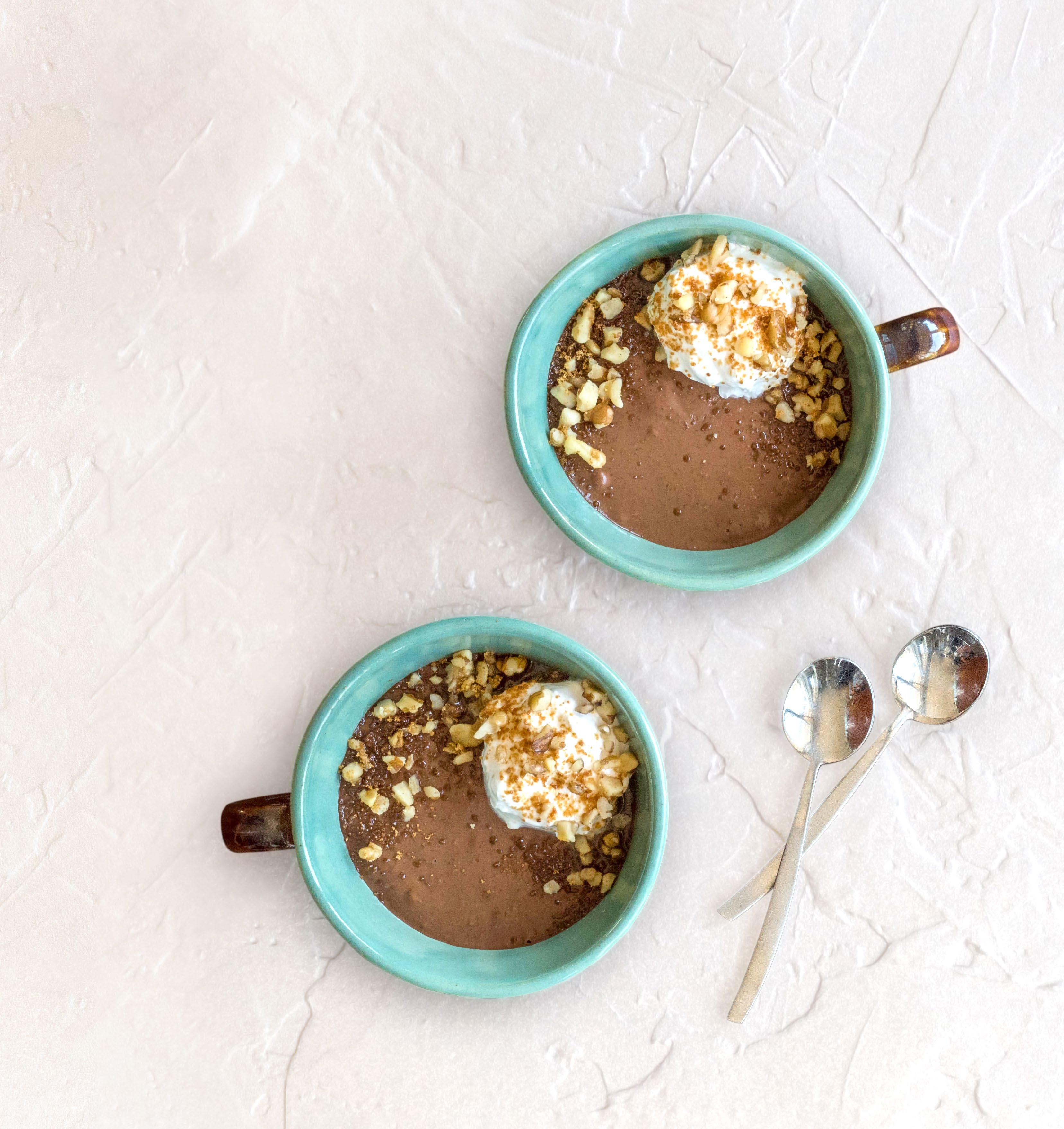
RESTAURANTS | RECIPES | WINES | FOOD | CULTURE Smart. Local. Delicious. FEBRUARY | MARCH 2021 ISSUE 25-01
years at the forefront of local food and drink INDEPENDENT & ISLAND OWNED ®
22
to
Cheerful:
be
Two for One Lamb
Sweet
Chocolate Mousse Spring! The
Spot

It’s the time of year when winter is fading to spring. Walks are not as bracing (or wet), the buds are getting plumper on the cherry tree branches, and the streets will be a bit livelier.
Halibut season is almost here, we can look forward to spring greens and the first sweet peas, and though winter may not be done with us yet, we can begin planning for our gardens.

In this issue, we’re treading that fine line between these seasons, making vegetarian pasta, roasting a leg of lamb that morphs into a dinner salad, and preparing a side dish that does double duty. And finishing off with a chocolate mousse that has a vegan twist.
Mara Jernigan takes us to Alert Bay to learn about a garden initiative with the hallmarks of a victory garden for the changing landscape we are in. Julie Pegg is inspiring us to put up some cold weather preserves. As we could all use some luck about now, Cinda Chavich looks at the tradition of eating “lucky” foods in a new year. Happy eating!
Cynthia Annett-Hynes
CITY EATS
If you haven’t yet taken advantage of Victoria’s free local delivery program, Downtown Delivers, you have until February 15 to try it out. This program was created to encourage Victorians to support local businesses during these challenging times by offering free local delivery from participating downtown restaurants and retailers. Learn more at dvba ca/downtowndelivers








Burger Crush has taken over 787 Fort St (previously occupied by Tacofino). Burger Crush puts a fresh and innovative spin on the classic burger shop, offering traditional and vegan versions of burgers and shakes. burgercrush.ca


You can now find Tacofino on Pandora Ave between Douglas and Blanshard. Their new, forty-seat corner spot is bright and breezy; they can’t wait to invite you all in to dine, but for now, they are offering take-out only from a convenient take-out window. tacofino com




 CYNTHIA ANNETT-HYNES EDITOR
CYNTHIA ANNETT-HYNES EDITOR
Welcome
REBECCA BAUGNIET
ILLUSTRATIONS: ISTOCK.COM/ANDREW_RYBALKO 3
CITY EATS
Parry Bay Sheep Farm Metchosin, BC
Parry Bay Sheep Farm along with Stillmeadow Farm sells lamb, pork and roasting chicken to restaurants and butcher shops in Victoria and through our on-farm market in Metchosin. We truly appreciate those who “walk the talk” and support local producers. From picturesque pastures to backyard barbecues Parry Bay lambs make people smile.
John & Lorraine Buchanan
250.478.9628 instagram: @parrybayfarm contact@parrybaysheepfarm.com facebook.com/parrybaysheepfarm www.parrybaysheepfarm.com facebook.com/ParryBayFarmMarket
Tacofino is behind some positive action, taking place in the form of Shift Change. This industry initiative encourages dialogue about issues prevalent in the hospitality industry like gender, diversity and inclusion, mental health and substance dependency to find meaningful and lasting solutions. At its core, Shift Change looks to support positive and sustainable change for our industry by inspiring people to take action. To find out more about their upcoming virtual events and learn more about this vital movement, visit shiftchangenow.com.
Friends of Dorothy is Victoria’s newest LGBT2Q+ cocktail lounge. Louis XIV meets punk chic at this modern Victoria gay bar, where you can share gourmet plates and sip craft cocktails. Friends of Dorothy launched its first location in Kelowna in early 2020 and followed that success with a second location here in YYJ. foodlounge com
Rain Dogs Wine Bar has opened at 509 Fisgard St. You will find artfully crafted and internationally inspired small plates to pair with their premier wine cellar and whisky collection. raindogswinebar com
On the cover: Chai Vegan Chocolate Mousse

Recipe + Styling + Photography: Isabelle Bulota
Recipe on page 26
Dumpling fans rejoice - there is a new dumpling place in town! Chubby Dumpling was born on December 29 at 1619 Store St. Dumpling offerings include bulgogi beef, pork and cabbage, pork, shrimp and chives, and veggie with glass noodles. Find dumpling soup and more on the menu. chubbydumpling.ca
Cat’s Coffee and Cake opened at 1213 Douglas St in October, with espresso and matcha beverages as well as beautifully decorated cakes and treats. Open Mon-Sat 8am-5.30pm. catscoffeecake.com
A long-standing local favourite for Chinese food, Dragon Gate Restaurant has closed permanently after twenty-seven years in business at 1609 Fort St. We wish the owners well.
Niche Grocerant is a hybrid grocery store/restaurant coming to Broadmead Village Shopping Centre. At Niche, you will be able to shop for the best local products while their kitchen prepares you a meal to go (prepped for take-and-make, or ready-to-eat). Or grab a table and a glass of wine or beer and let Niche serve you. nichevictoria ca
Bar 500 is the new eatery at the Oswego Hotel on Menzies. Mornings at Bar 500 feature the finest in local bites and coffees. They have partnered with Bows & Arrows Coffee Roasters, and their pastry selection is made in-house. Evenings at Bar 500 highlight globally inspired sharing plates along with truly inspired and authentic beverages. oswegohotelvictoria.com/bar-500
A secret home bakery has popped up in a 130-year-old house in the James Bay neighbourhood. Deer & Dough Bakery makes traditional baked goods you can pre-order and pick up. Cakes, sweet and savoury pies, mini Bundt cake flights, and cookies are all on offer. Using fresh and seasonal ingredients sourced locally. Not a storefront, but place an order and stroll on over to pick it up. Find @deeranddoughbakery on Instagram or Facebook.
A new pizza place is coming to Brentwood Bay. Bicycle Pizza has been hosting pop-ups at the Beauregard Café on West Saanich Rd. Follow @eatbicyclepizza on Instagram to stay in the loop. Visit eatmagazine.ca for more articles, recipes, news and events.
FOUNDER
Gary Hynes
PUBLISHER
Pacific Island Gourmet EDITOR
Cynthia Annett-Hynes
CONTRIBUTING EDITOR/COPY EDITOR
Carolyn Bateman
VANCOUVER CONTRIBUTING EDITOR
Julie Pegg
SENIOR WINE WRITER
Larry Arnold
LAYOUT AND DESIGN
Cynthia Annett-Hynes
PRODUCTION AND DESIGN
Amanda Batchelor
REGIONAL REPORTERS
Victoria, Rebecca Baugniet
CONTRIBUTORS
Isabelle Bulota
Nate Caudle
Cinda Chavich
Jennifer Danter
Jacqueline Downey
Gillie Easdon
Deb Garlick

Kyle Guilfoyle
Justus Lowry
Lillie Louise Major
Denise Marchessault
Elizabeth Monk
Daniel Murphy
Elizabeth Nyland
Daisy Orser
Adrian Paradis
Mara Jernigan
Adrien Sala
Shelora Sheldan
Johann Vincent
Rebecca Wellman
REGIONAL/NATIONAL ACCOUNT MANAGER
Susan Worrall
ADVERTISING ACCOUNT MANAGERS
Ron Metella
Cynthia Annett-Hynes
CONTRIBUTING AGENCIES iStock.com pg. 3, 6, 20
FACEBOOK/EATMAGAZINE
TWITTER/EATMAGAZINE
INSTAGRAM/EATMAG
For advertising and other inquiries:
PHONE
250-384-9042 / 778-350-6962
EMAIL editor@eatmagazine.ca sales@eatmagazine.ca
ONLINE
EatMagazine.ca
MAILING ADDRESS
Box 5225, Victoria, BC, V8R 6N4
STOCKISTS
EAT is delivered to over 200 pick-up locations in BC.
PRINTED IN CANADA
EAT® is a registered trademark.
No part of this publication may be reproduced, stored in a retrieval system, or transmitted, in any form or by any means, electronic, mechanical, photocopying, recording, or otherwise, without the prior written permission of Pacific Island Gourmet / EAT Magazine.
EST. 1999
FEBRUARY / MARCH
4 FEBRUARY/MARCH 2021


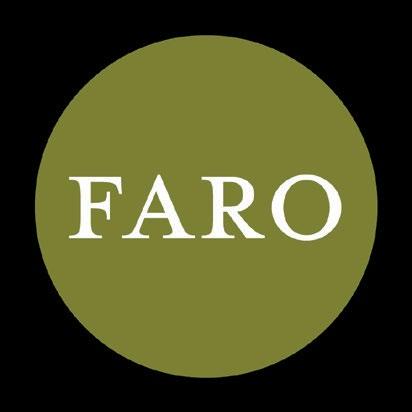









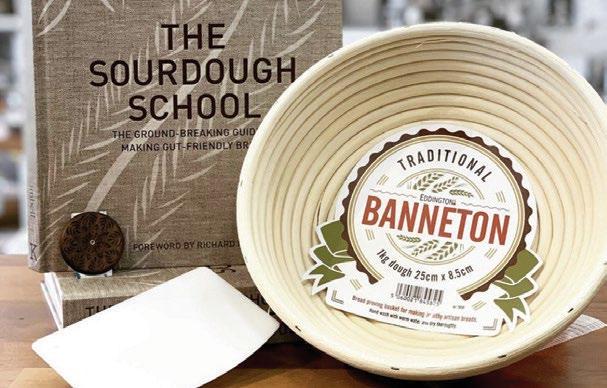







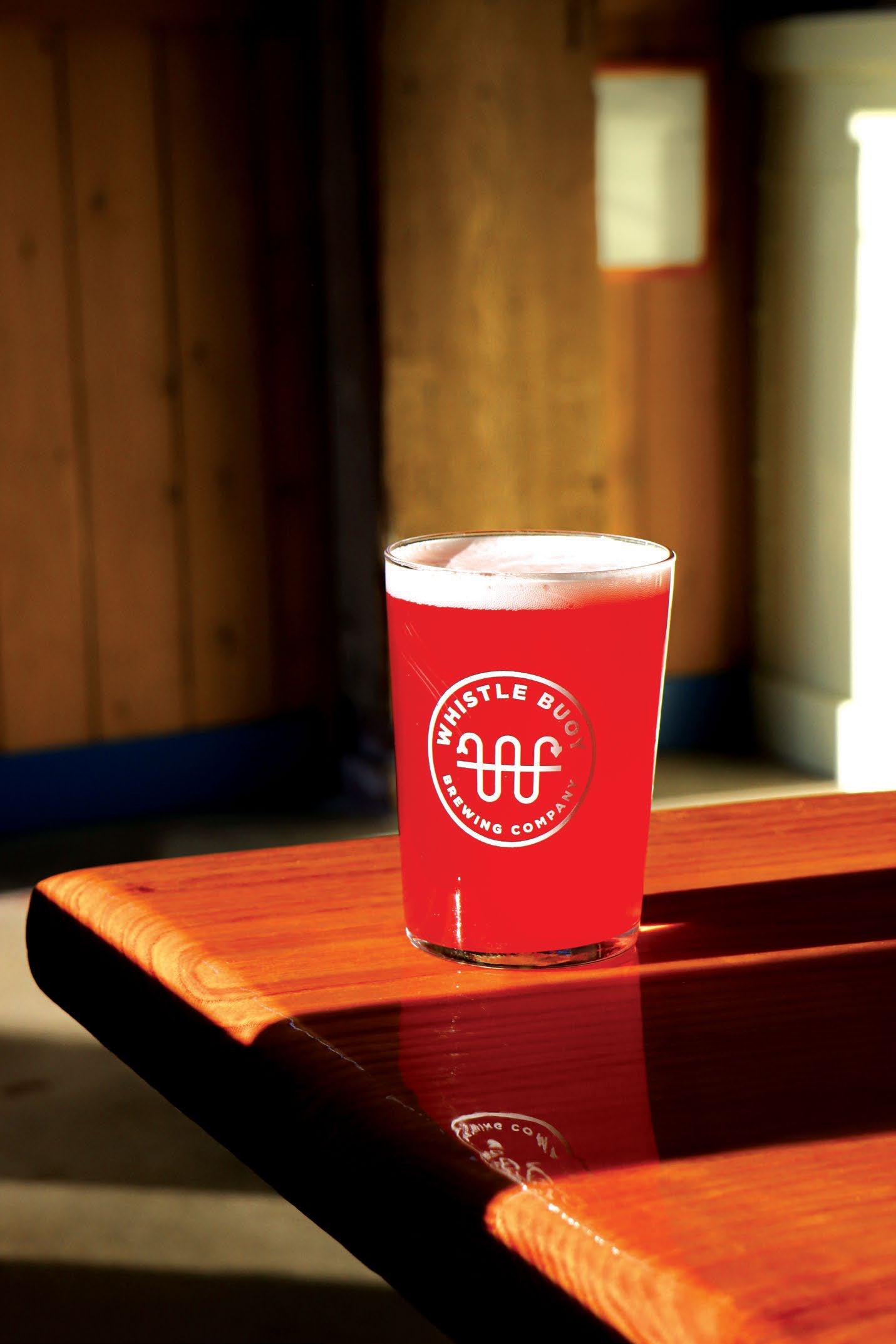
handcra ed pizza, custom cocktails, local wines, outdoor patio & new indoor pop-up patio FARO Lane CAFÉ LUNCH DINNER #1-6332 Metral Drive, Nanaimo 250.933.1800 www. .com all the best tools for your kitchen SHOP ONLINE FOR DELIVERY OR CURB-SIDE PICKUP 5
GETTING PICKLED
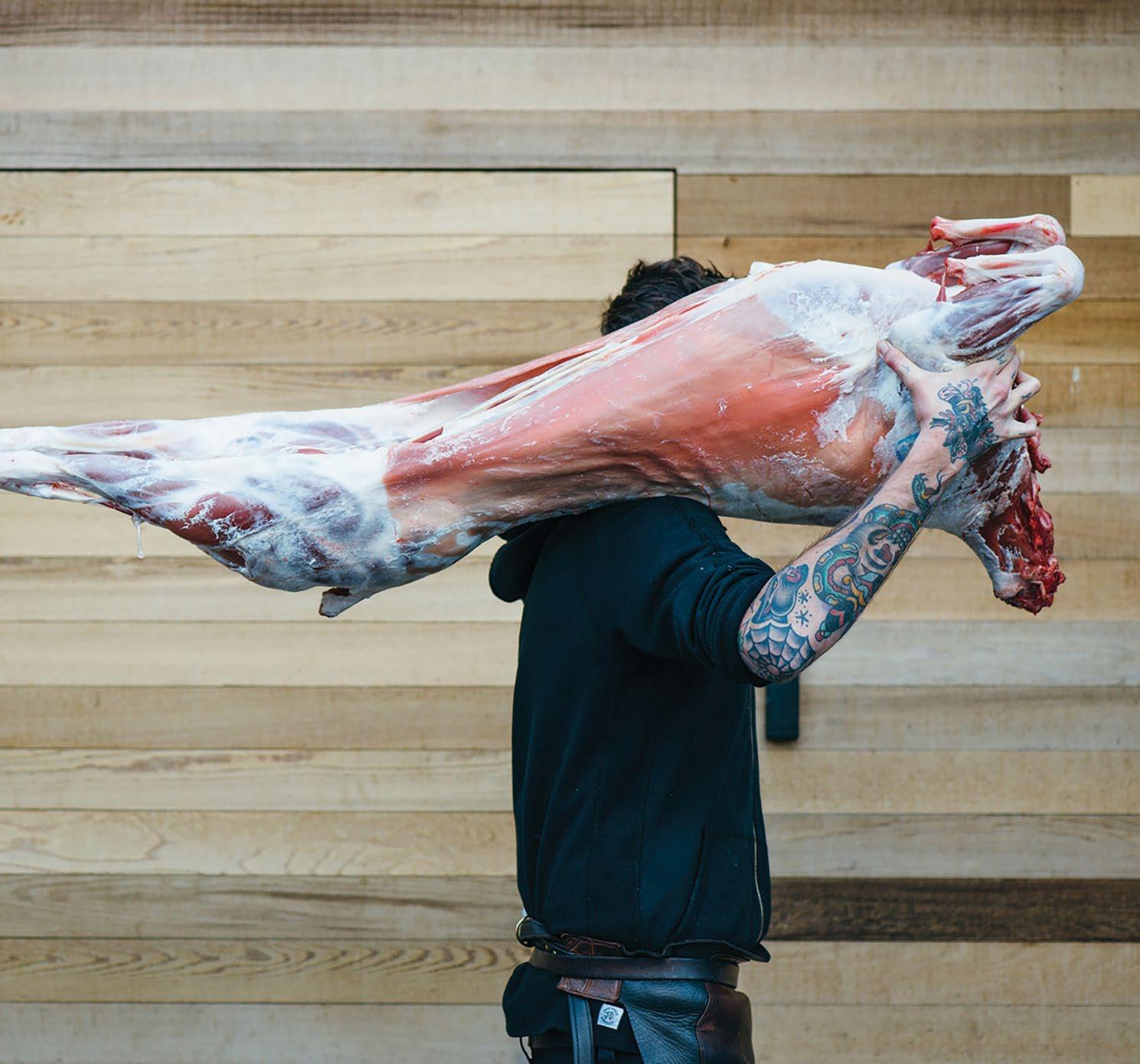


Julie Pegg is putting up cold weather preserves like Persian lemons and Branston pickle.

AS I WRITE THIS, only an oracle could prophesize what awaits us come February. Certainly, annus horribilis 2020 will be behind us and we can look toward brighter days ahead as buds peep through soil and poke from branches. All being well, we will appear less like bandits and ready for our shot (two actually) in the arm and having a laugh over a nosh and a drink (or two!) with friends.
Fidgety with anticipation I’m getting a culinary jump on the seasons. The Weber is being liberated from its winter grime and I’m poring over grilling recipes. New canning jars are sterilized and ready to fill. As someone obsessed with briny addons and add-ins for cold plates, sandwiches, and burgers, or to add a tang to soups or stews, I am putting up cool weather preserves.
Lemons (technically a pickle, as they are brined) have priority. Persian lemons are usually available in Middle East grocers this time of year. Left to rest in a jar of salt-packed lemon brine for about a month, the sweet, low-acid lemons are ready for chopping and whisking into a tangy aioli, which I intend to slather on a firstof-the-season grilled halloumi burger. For an early spring Sunday repast, I’ll make Ottolenghi’s lentil and preserved lemon ragout or Jamie Oliver’s easy-peasy lamb shoulder slow-cooked over a bed of chickpeas, plum tomatoes, and finely chopped preserved lemon. Or I’ll toss a bit of rind into braised red cabbage.
Pickling onions large and small requires little effort. For a Dirty Gibson, add two or three pickled pearl onions to vodka or gin, spiked with a dash of the brine and a dash of dry vermouth. Shake or stir it and offer it to that first guest to cross your threshold in months. If you’re still an abstainer after these last crazy months, then good on you. A couple of pickled asparagus spears sit nicely in a glass of spicy Clamato juice.
Most vinegars of five percent acetic acid or more will pickle any vegetable. (Think fennel, radishes, squash, parsnips, or a combination of winter or early spring vegetables.) Distilled white vinegar is the norm for pickling, though I tailor particular vinegars to their mates. Sliced carrots and daikon radish, for instance, partner well
Food Matters JULIE PEGG ILLUSTRATIONS: ISTOCK.COM/CANICULA1 6 FEBRUARY/MARCH 2021
with rice vinegar—excellent for salad rolls and cold Asian noodles. Beets pickled in cider vinegar lend a mellow note to a pear, walnut, and goat cheese salad, or a spinach and bacon salad with maple dressing.
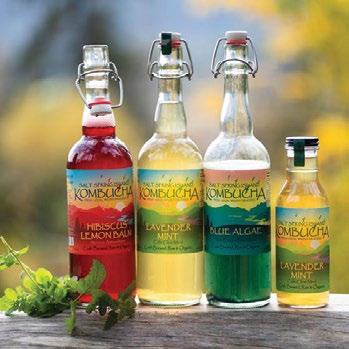


The English are enamoured of their malt vinegar (think fish and chips). Who am I to argue with a nation that ferments malt vinegar with the same grain used to brew good ale? I’ve pickled pub-style eggs and onions (not in the same jar) in malt vinegar with delicious results. There’s no better condiment for a hunk of aged cheddar and a thick slice of crusty bread than Branston pickle, where malt vinegar is also the star.
Since I was pretty much under house arrest and the last morsel of my coveted Branston was gone, it became imperative I give it a go at making it too. The litany of ingredients barely fit on the back label—swede (rutabaga), cauliflower, onion, marrow (large mature zucchini), apples, dates, gherkins, garlic, spices (mustard, cayenne, cinnamon, cloves), barley malt vinegar, lemon juice, tomato paste. Why such a hodgepodge, I wondered? Was India’s chutney the inspiration for the 1922 recipe attributed to Mrs. Caroline Graham of the village of Branston in Staffordshire, England? Or was all this stuff just languishing in her larder and she figured, what the heck—I’ll just toss it all into the pickling pot? Couldn’t discover a thing.
A 2008 Canadian Living recipe for making Branston calls for the same ingredients (except the tomato paste), everything from apples to zucchini. I sliced and diced by hand each ingredient as Dvorak’s Cello Concerto, performed magnificently by the late cellist Jacqueline Du Pré, kept me company courtesy Julie Nesrallah on CBC Radio 2.
As the fruit-vegetable mixture slow-simmered on the stove, the kitchen became pungent with the vinegar but also filled with warm, savoury aromas. For an entire morning I managed to lock out an upside-down world.

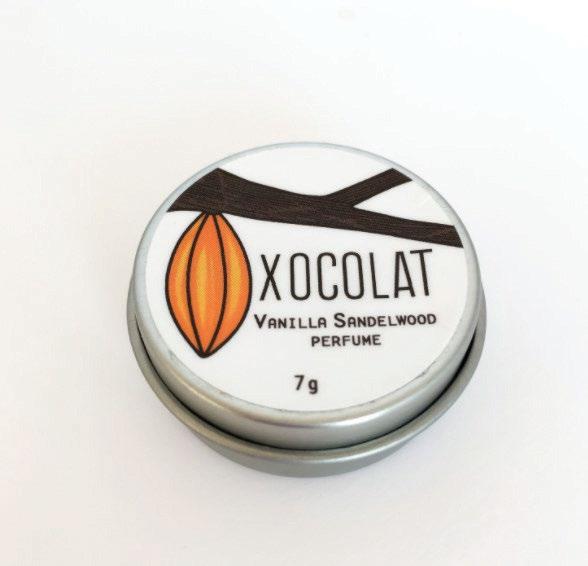






My Branston facsimile turned out very well indeed, less sweet and sticky than the commercial version, but bright with spice and tang.
Bring out the Branston™ is the logo on the jar lid. I look forward to sunnier days, to having friends pop by. I will share a loaf of bread, a bottle of ale, and a chunk of aged cheddar, and bring out my version. I made a lot!

NEW BUBBLES FOR YOUR BUBBLE Introducing Spinnakers Sodas and Sparkling Mineral Waters. Ask for Spinnakers new non-alcoholic bubbly drinks in loads of fun flavours at your local grocery and Victoria’s premier local & organic farmers market Every Saturday! May- Oct 10am to 2pm Nov - Apr 10am to 1pm Now also online at localline.ca/moss-street-market Market Farmers Moss St. Est. 1992
7
Eating Well for Less

FINE DINING MADE SIMPLE
These times are an excellent opportunity to experience high-level craftmanship in an accessible menu.
Saveur

658 HERALD ST., 250-590-9251
A COVID STRATEGY SOME FINE DINING establishments are offering is a simpler menu for less. In the case of Saveur, a menu of “hand-helds” and “bowls” lends itself to take-out. But fine dining chefs have a gene they can’t control—to tweak, perfect, and add levels of flavour. So the “simple” food you order can end up being quite sophisticated. This is the case at Saveur, which has historically prepared multi-course tasting menus.

Run, don’t walk, to take advantage of this Covid-times menu and enjoy the Korean Pork Belly Sandwich, the Fish Tacos with Lemon-Caper Aioli, or the crazy, multistep appetizers like Mushroom Crackling and Salt Spring Mussels Escabeche. This is an opportunity to experience high-level craftmanship in an accessible menu.

The Mushroom Crackling for $8 is pure alchemy. It has the flavour power of pork crackling with the airiness of rice crispies. And it is vegan. Tapioca pearls, dehydrated mushroom, and dehydrated kimchi all take part in the magic. The mussels on the appetizer menu are pickled, then fried, and served with a tarragon aioli in a sensuous stone bowl. It is surprising that this special appetizer is only $6.
The Korean Pork Belly Sandwich is served with a knife stabbed through it—the perfect symbol for these angst-ridden times! The pork belly, caramelized and meaty, is enhanced with a sprinkling of sesame and peanuts, moistened even more with spicy yogurt, and given some tang with pickled fennel. This is a dynamic and interesting sandwich for $14.
The fish tacos were on point for $18, with fresh local fish, lemon-caper aioli, and jalapeño-cilantro crème fraiche, all on authentic nixtamal corn tortillas. A vegan option is the Soba Noodles Bowl for $17 in a creamy, misobased sauce and served on a brushed streak of wasabi.
Check the website for opening hours, since we are living in fluid times, and enjoy this pivoted menu while you can.
Business For Sale Brad Archibald 778 690 2090 Cold Front Gelato Authentic Gelateria in Downtown Nanaimo collierscanada.com Slaters FIRST CLASS MEAT 1983 LTD. 250.592.0823 ∙ 2577 Cadboro Bay Road Get fired up for spring! rediscover the blue crab Local, fresh and healthy dinner offerings that will make you shellebrate! Join us in our lounge, we’re open daily. COAST VICTORIA HOTEL & MARINA BY APA | RESERVE AT BLUECRAB.CA OR CALL 250.480.1999
ELIZABETH MONK
ELIZABETH
8 FEBRUARY/MARCH 2021
SOBA NOODLES WITH MISO DRESSING, GARDEN VEGETABLES, MUSHROOMS, PICKLED FENNEL
NYLAND
The Pacific Restaurant
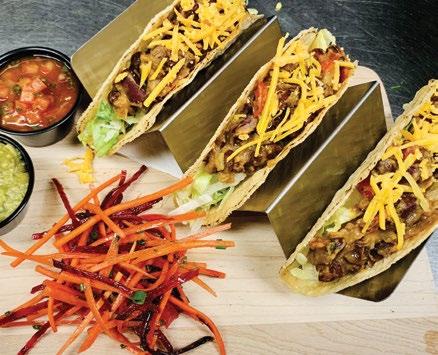
HOTEL GRAND PACIFIC, 463 BELLEVILLE ST. AT QUEBEC ST., 250-386-0450



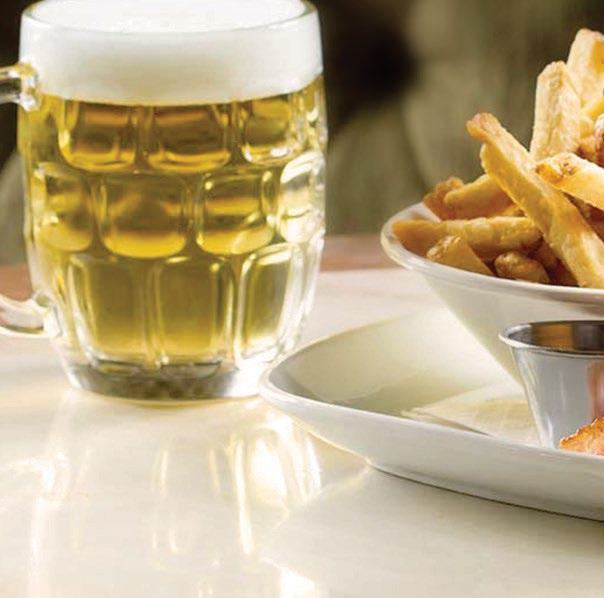

IN COVID TIMES, IT IS EXTRA IMPORTANT for me to create a feeling of an event or party when I dine out with my family. Enjoying the early bird special at The Pacific Restaurant is a way to enjoy a classic, elegant, wood-trimmed dining room with views of the Inner Harbour—and pay only $20 for a three-course meal. The room is spacious—you will be nowhere near another diner.
Starters are a choice of salad or, for two extra dollars, clam chowder. The salad is beautifully dressed with a homemade Green Goddess dressing and is sprinkled with sunflower and pumpkin seeds. And the clam chowder is well worth the extra $2. Its flavour structure is bolstered by double-smoked bacon, and the creative use of candied salmon adds a top note of sweetness.
Three mains are available on the Early Bird Menu. I tried two: the Butternut Squash Pizza and the Fish Pie. Again, like at Saveur, it is hard for a fine dining chef to simplify too much, and again, the diner is the beneficiary! The pizza toppings are a mix of tart and sweet, with lightly seared cherry tomatoes playing with the flavours of sundried tomatoes and tiny cubes of butternut squash. Dainty pieces of kale and buttered leeks also appear on this pizza. And the crust is airy, with a bit of crunch on the edge.
The fish pie was plump with fish and shrimp in a rich bechamel and dill sauce, with piped buttery mashed potatoes on top and a flaky pastry on the bottom. This pie and other main dishes are also available for take-out through the Hotel Grand Pacific at Home program, which is worth checking out.
A white chocolate and cherry pound cake was beautifully presented with three little clouds of cream and a pleasantly tart cherry compote.
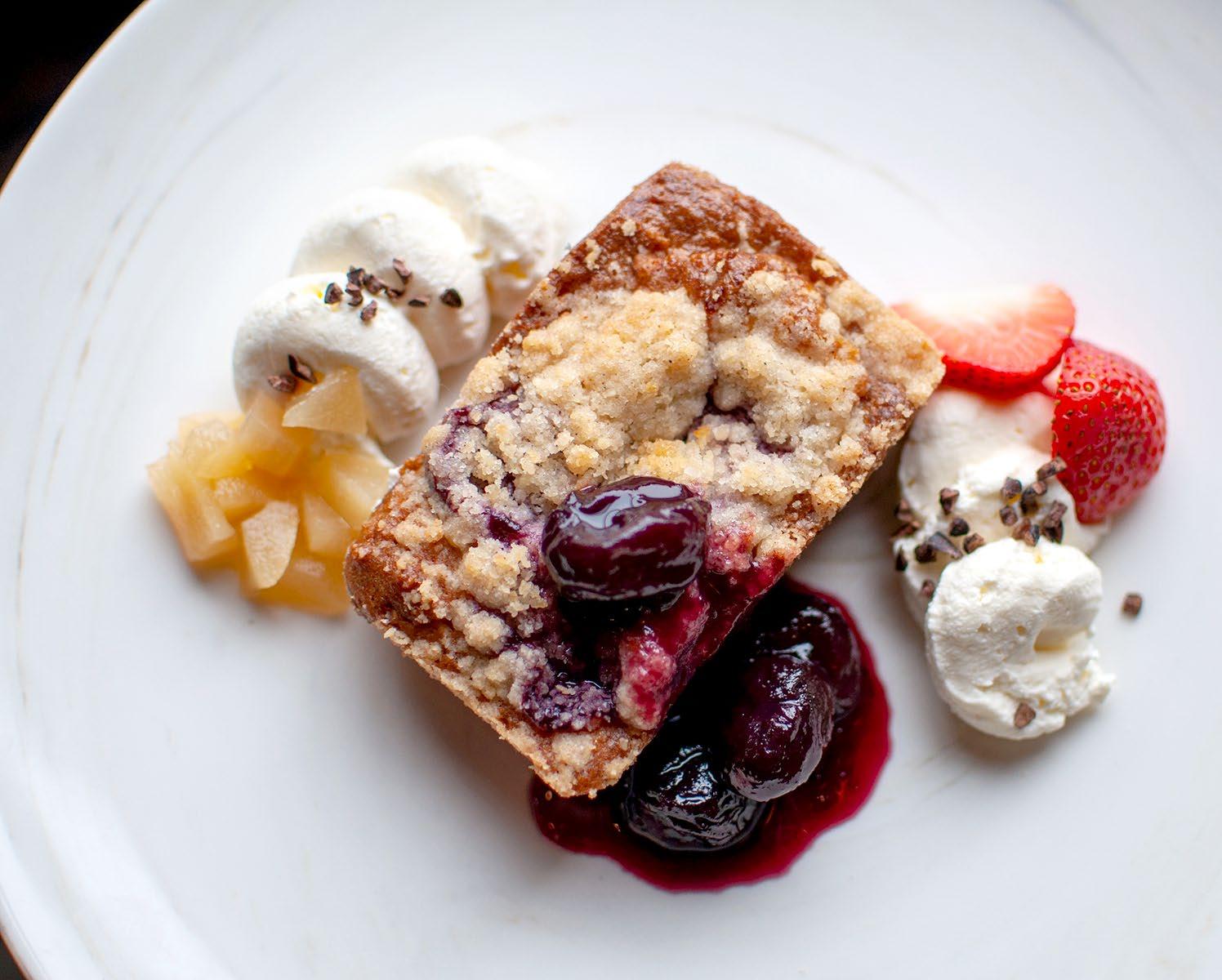
The early bird special pulled me in, and I will definitely be back to check out their three-course fondue dinner to create a different special night with my family.





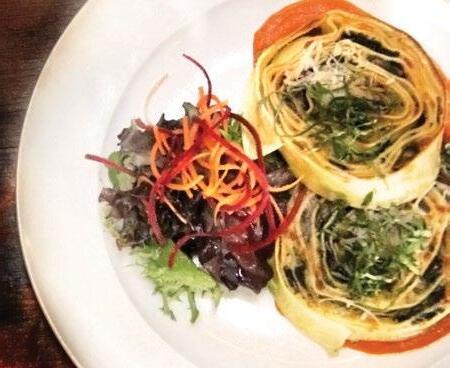
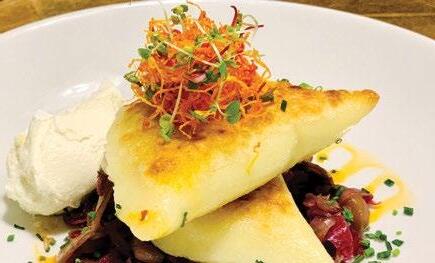

Guinness Burger steroid + hormone-free BC beef gluten-free option available Try it with Hoyne Pilsner barley, hops, yeast, water · vegetarian S U S T AI N AB L E L O C A L C O MMUN IT Y sixmilepub.com · 494 Island Highway at Six Mile Rd Safe Dine-in, Take-out & Delivery Scan to view our safety plan Familiar Foods. Elevated. White Cheddar Beer Perogies vegetarian · gluten-free Slow Braised Bean Tacos vegan • gluten-free Artichoke + Roasted Mushroom Lasagne vegetarian EAT Magazine: Best Pub to Take a Kid YAM Magazine: Best Pub Runner-Up @NICHEVICTORIA.CA @NICHEGROCERANTVICTORIA
WHITE CHOCOLATE AND CHERRY POUND CAKE, CHERRY COMPOTE
9
ELIZABETH NYLAND
TO MARKET TO MARKET
Making connections, one shop at a time.
CYNTHIA, OUR LOVELY EDITOR and owner of EAT magazine, told me a beautiful story once. About how much Gary, her late husband and EAT founder, loved to grocery shop. It was this love of his that brought us together, and why you read my words right now.

The story goes that Gary loved to grocery shop so much it would often consume their weekends, leaving scarce free time for much else. This was fine with Gary because he loved it. Cynthia, however, loved it slightly less. In hopes of freeing up their weekends, it was upon her suggestion that they integrated a visit to a market into a new weekly date night, elevating it to something to look forward to for her. And so a tradition was born; they would go for a beautiful dinner, savour a glass or two of wine, and of course each other’s company. On their way home, they would go to a market (Gary liked to change it up and support different local stores) to shop when spirits were light, bellies were full, and there was no rush to be anywhere else. They would take their time and plan their meals based on what was in season, what appealed, and what caught their fancy.
Imagine if we did it on purpose?
teaches us about love, about food values, and how intrinsically connected they are.


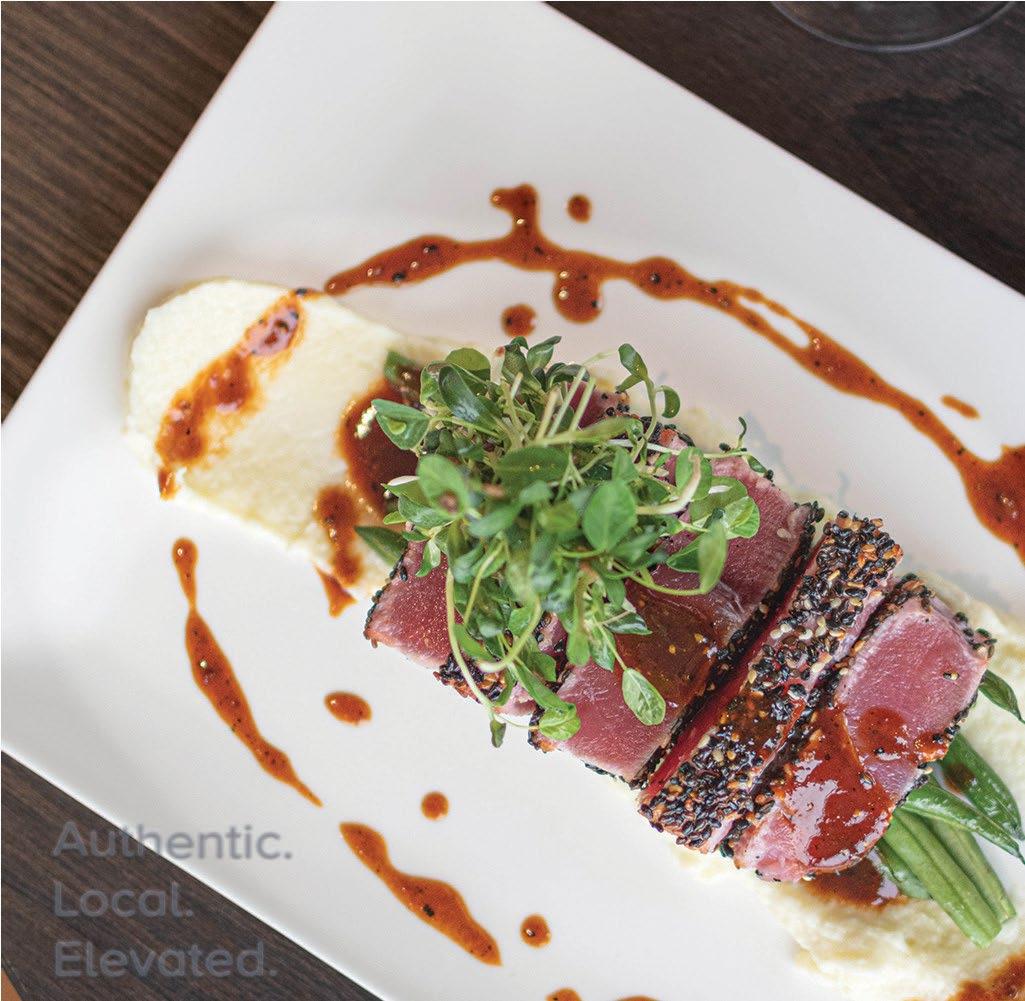
Covid has gifted us a certain clarity. We’ve each learned what we can do just fine without (networking), what we can do just fine with less of (hair cuts), what that one thing is that keeps us from coming undone (nature), and what matters the very most at the end of the day. For me and for many, this final thing is connection. Many of us have found creative ways to make connections and fulfill this need; zooming loved ones, choosing phone calls over texts, baking bread for a neighbour. Opportunities abound to elevate the value of the everyday activities that we have access to.
Imagine if we did it on purpose?


You now know the story of how Cynthia learned to love to grocery shop, well before the pandemic, and why Gary will always be with her when she goes to the market.
I love that Gary’s food values were ahead of their time; he was a trailblazer on the food scene. So let’s stay on the trail, pull the weeds, make the time, and find our own ways to savour the mundane parts of this thing we must do to survive. Love is in the air this time of year, so let’s challenge ourselves to find a way to love peeling potatoes, taking out the compost, or grocery shopping. Let’s make eating, and all of the chores that come with it, spectacular.


To learn that a visit to our shop was often the favoured grand finale to an evening spent together makes all my inner songbirds sing. But I love even more what this
Daisy Orser is co-owner of The Root Cellar Village Green Grocer
250 382 9258 vista18 com Top Floor, 740 Burdett Ave Inside Chateau Victoria Hotel Authentic. Local. Elevated Recipes, pairings and more at saltspringkitchen.com Enthusiastic Eats DAISY ORSER
Opportunities abound to elevate the value of the everyday activities that we have access to.
10 FEBRUARY/MARCH 2021
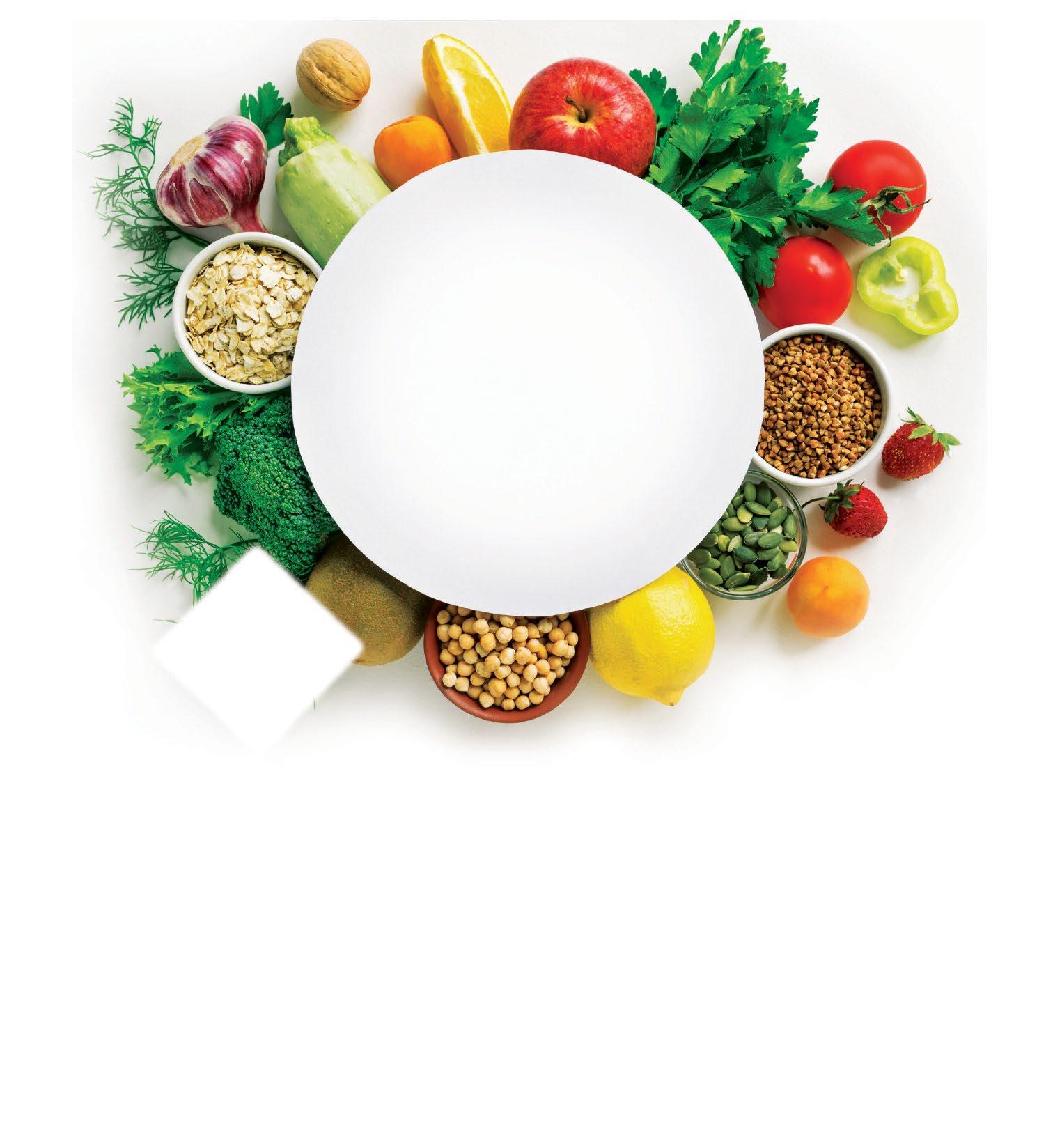

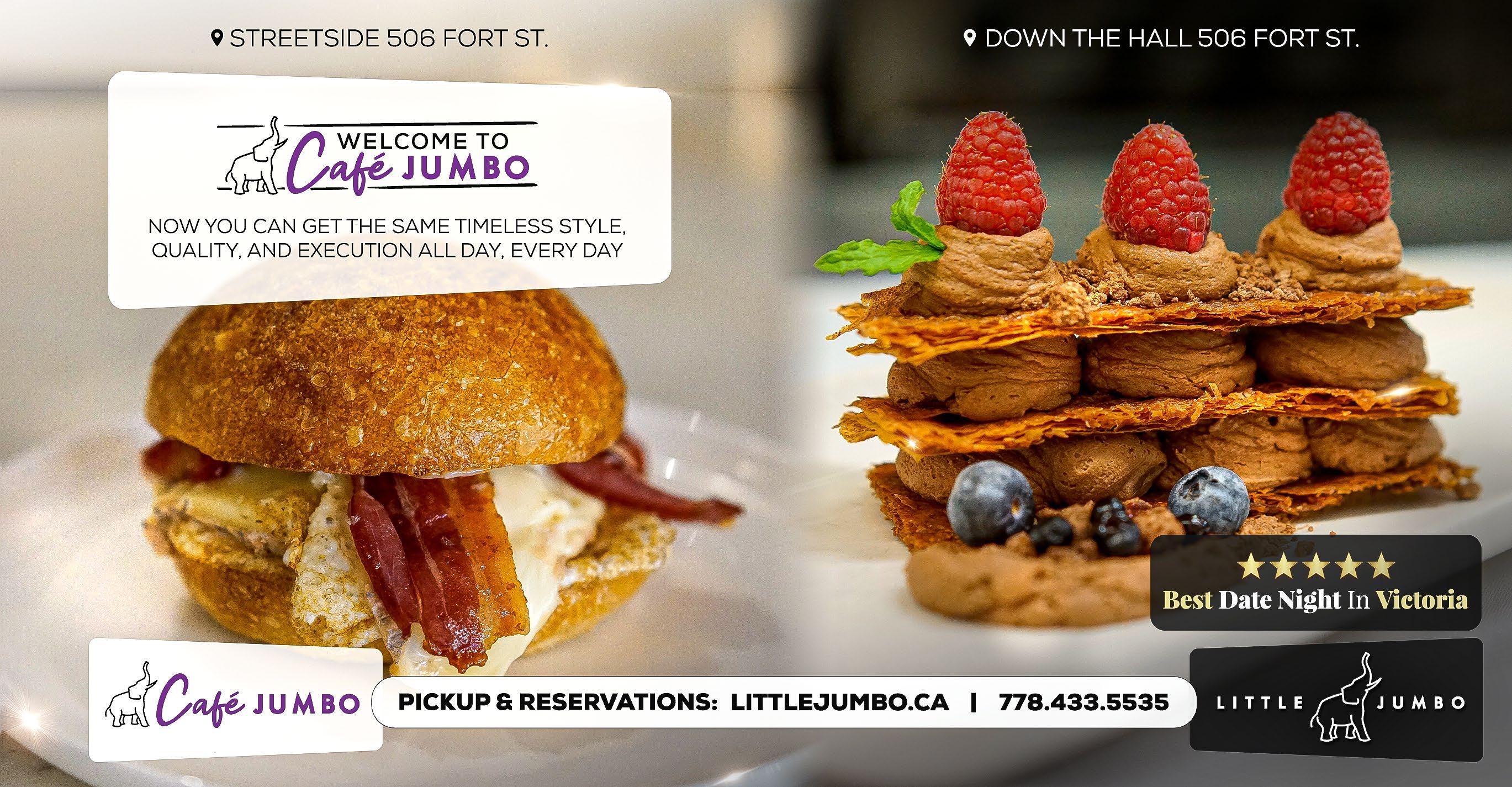
Handmade Ethical Local Traditional CURED AND SMOKED MEATS 2032 OAK BAY AVENUE, VICTORIA 250.590.PORK THEWHOLEBEAST.CA CURED@THEWHOLEBEAST.CA 11
Step in from the Cold at Rain Dogs Wine Bar


The new Chinatown wine bar brings a warm, boisterous atmosphere to the old OLO location.


“It’s kind of like an adult playground,” says Rennie, who wants to reflect some of that in his restaurant. Rennie, who is a project manager by trade, turned his attention to his newest venture and took over the space on November 1. Within six weeks it was reborn as Rain Dogs Wine Bar (a nod to Tom Waits and his song about the refuge some folks find in watering holes).
DRINKS
Rennie has used his management skills to put together a solid team to help build out his vision. Front of house manager Charleen Büter (who goes by Charly) hails from Germany and has a deep background working throughout Europe. Büter has some hefty feathers in her cap too, like the Copenhagan restaurant Geranium, voted the fifth best restaurant in the world in 2019. She brings some of that sensibility and approach to her role here.
The wine list leans toward European (although BC is well-represented), and has been well thought out for everyone from the expert to the simply curious. One of the most interesting offerings is called The Blind Date ($22), a wine flight in which the consumer isn’t told what is on offer until it has been sampled.
THE FIRST THING THAT STRIKES YOU when you walk into Rain Dogs Wine Bar is that it feels very different to its predecessor, OLO. While the former was lovely and had all the hallmarks of a great restaurant, it was somewhat subdued in its atmosphere, with hushed conversations amidst tightly spaced tables. Rain Dogs is not that. Rather, the new restaurant owned by Chad Rennie has a more boisterous feel—a sentiment amplified by a massive three-panel painting along the back wall by Canadian artist Mitchell Villa. The painting, titled Bacchanalia, features Bacchus, the Roman god of agriculture, wine, and fertility. It’s a scene of hedonistic indulgence, with overflowing wine and lightly clothed goddesses enjoying the splendour with the god.
“It gives the customer a chance to try something before having an opinion about it,” says Büter. People naturally have biases or opinions about certain varietals, but there’s a big difference between, say, a chardonnay from California and one from Burgundy in France. This is a chance to step out of the box a bit—or to just experiment and have fun.
And although the place calls itself a wine bar, there’s also a deep bar of interesting whiskies, something Rennie is passionate about. From British Columbian to Japanese, Irish, Scottish, and American, there are whiskies for every palate. Flights start at $19—but if that’s not your jam, there are several different cocktails to choose from.
509 FISGARD ST. 250-590-4665 RAINDOGSWINEBAR.COM
Owner Chad Rennie
LILLIE LOUISE MAJOR
LILLIE LOUISE MAJOR
JUSTUS LOWRY
JUSTUS LOWRY
REPORTER 12 FEBRUARY/MARCH 2021
Charcuterie and Cheese Board (Image courtesy of Rain Dogs Wine Bar) Squash with roasted squash puree, with a brown butter hollandaise (Image courtesy of Rain Dogs Wine Bar)
FOOD















What brought Charly Büter to Canada, you might be asking? Well, the chef, who also happens to be her partner, is originally from Vancouver Island. Prior to the move home, chef Landon Crawford worked in several well-known restaurants throughout Europe, including the historic Hotel D’Angleterre in Copenhagen.

“I kind of missed home,” he explains. “And I was curious to see what the food culture was like here after years away.”
Crawford has brought his European experience to Rain Dogs Wine Bar and melded it with the local ingredients. The small plates menu, which fluctuates based on season, reads very simply yet is quite complex and thoughtful. The beef cheeks ($19), for example, take about 30 hours to prepare.
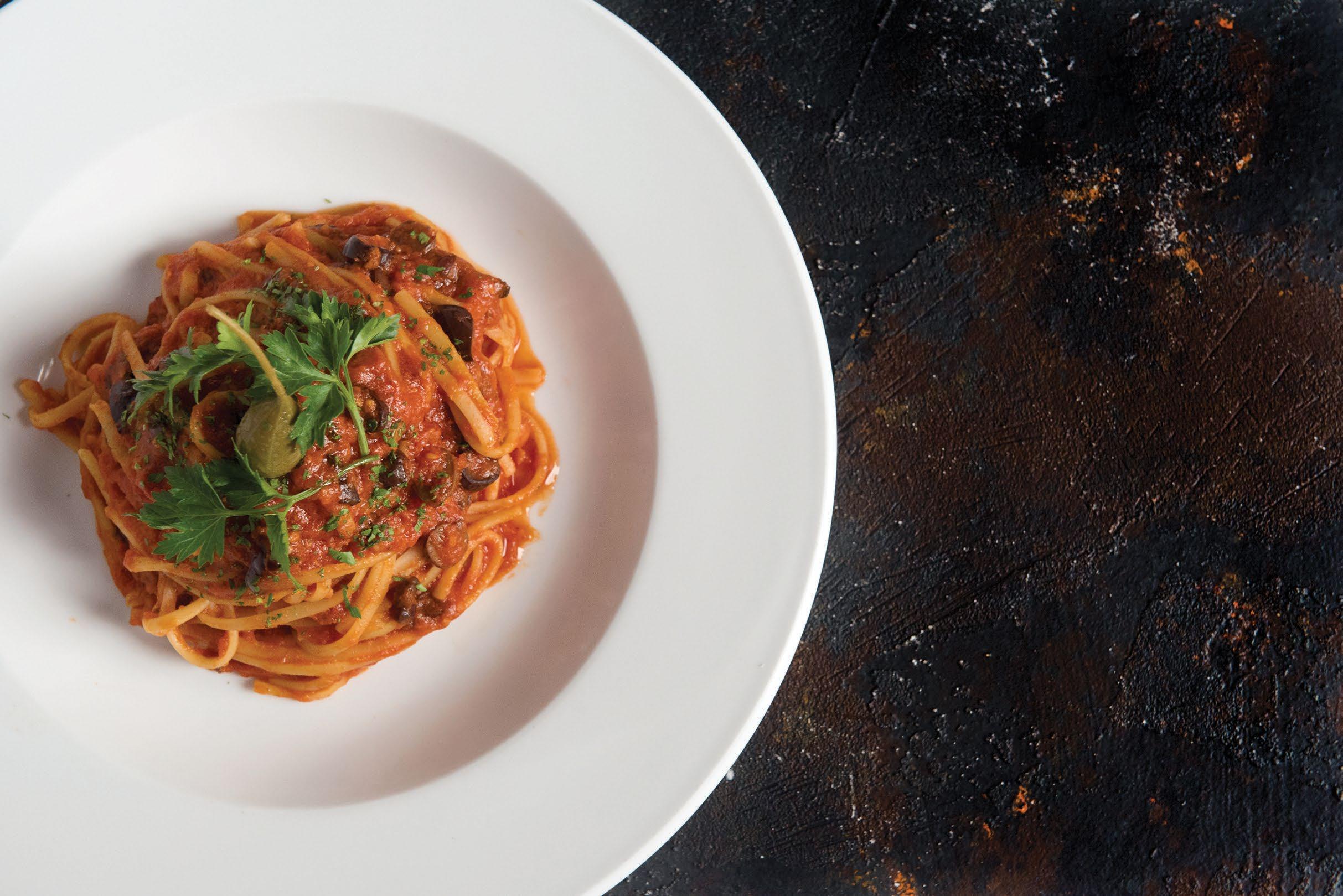
“There’s a lot of aging that goes into things like our sauces, giving them depth and flavour,” he says. “Really, it’s old school techniques with modern application.”

One of the most interesting plates on offer is the squash dish ($14). Roasted acorn squash sits atop roasted squash puree, with gremolata, kale chips, and dried squash, as well as a brown butter hollandaise. It’s also accented with fermented squash juice that has been reduced into a glaze. The depth of flavour of this dish belies its title on the menu, which is simply “squash”—a purposeful composition designed to ignite conversation. In fact, Crawford likes to engage with customers directly when possible and encourages chefs to run food to tables when they can. He hopes it gives diners a chance to ask questions about the food.
If you’re more interested in simply snacking while enjoying a drink and the atmosphere, the charcuterie and cheese boards are an excellent option too. As Rennie explains, he wants Rain Dogs Wine Bar to feel like a place where you can lean into being an adult. Perhaps not quite as indulgently as Bacchus, but by filling your glass and enjoying what the world has to offer.
ADRIEN SALA


Cucina Italiana 106 Superior Street | 250.380.0088 | IlCovoTrattoria.ca Dinner ~ Wed to Sun from 5pm ENJOY A TASTE OF ITALY AT HOME: TAKE-OUT AVAILABLE: Online orders for pick-up or delivery. Offering meals ready for your table or prepared to cook at home. DINE-IN: Reservations call 250-380-0088
13
REPORTER
Finding Their Niche
Industry veterans Ceri Barlow, Jami Wood and Andrea Duncan are bringing the European concept of the “grocerant” to Broadmead Village.

“BY THE WAY, THEY’RE BRINGING LUNCH,” cook Andrea Duncan informs me as we sit at her backyard picnic table with her old, blind, and grumpy chihuahua Lily and adorbs mutt puppy Lola. I should’ve known. Of course hospitality lifers and libation mavens Ceri Barlow and Jami Wood would be bringing delicious food, and probably a tasty beverage, to our interview. The topic?

Niche Grocerant—coming to Broadmead Village March 2021.
A grocerant is a hybrid grocery store/eatery. A fixture in many European countries, they’ve come more into vogue in Canada over the last few years. But to describe what Jami and Ceri are creating and offering to Broadmead with this simple word glosses over the gold in this culinary community treasure chest.
Niche Grocerant is located in the former home of Dig This at the entrance to Broadmead Village. At 1,132 square feet, it is being purpose-built in a WestcoastEuro style by local talent Edda Creative and will feature local artisanal foods, fresh produce, packaged meats, a licensed patio, take-home meals, and a selection of zero-waste meal box programs. Up to 30 guests can dine in, with 20 on the patio post-COVID, with restrictions splitting inside dining by half. Local and international wines, craft beers, and cocktails will also be available to consume onsite with food or delivered with to-go meals. Deeply committed to local food security, Niche Grocerant is also a community hub for the education and celebration of the bounty we enjoy here on the Island. Its front-and-centre location circumnavigates concerns that it might be lost in the outdoor mall-ness of Broadmead Village.
So, let’s start with Niche Grocerant’s artisanal foods. At the kitchen’s helm is talented, straight-up industry veteran Andrea Duncan. Her past kitchen credits include CinCin Ristorante + Bar, Blue Water, Cafe Brio, Foo Food, and Heron Rock. Each day she’ll offer a meat, vegetarian, pasta, keto, and egg dish. Ingredients depend on what local farmers deliver that week, and there will be fresh, dried, and fermented in-house delights for sale. Niche Grocerant is working with all local farmers, upcoming and established. Guests are welcome to eat in or take drinks and meals home.
Jami and Ceri do indeed bring delicious food, and as we tuck into our flank steak from The Village Butcher, a sprouts-based salad, and a bottle of Averill Creek Charme de l’Ile, Ceri’s dog Frankie plays with Lola. Lily hysterically yaps her disapproval as Ceri and Jami share their vision. “Basically, we all succeed or we all fail. When outside sources can’t reach us due to shortages, pricing, environmental changes, and pandemics, it’s crucial that local products are readily available.” The BFF duo’s concept for Niche Grocerant’s true business success embraces the farmers, other eateries, bakeries, and fine purveyors of food and drink. Over the canine chaos, they share their succinct vision: “We’re bringing Oak Bay and downtown Victoria and other area’s specialties to Broadmead.” This means packaged meats from The Village Butcher and The Whole Beast, seafood from Finest at Sea, coffee from Mile Zero Roasters, dumplings from Dumpling Drop, and even the venerated Pagliacci’s bread (this news blew up their social media) and more. Niche Grocerant is committed to selling local, but also actively participating as educators, and as a potential venue for the Islands Chef
BROADMEAD VILLAGE, #480-777 ROYAL OAK DR. 250-483-1274 NICHEVICTORIA.CA
14 FEBRUARY/MARCH 2021
Collaborative (ICC), Farm Folk/City Folk, and Growing Chef’s educational and fundraising events.


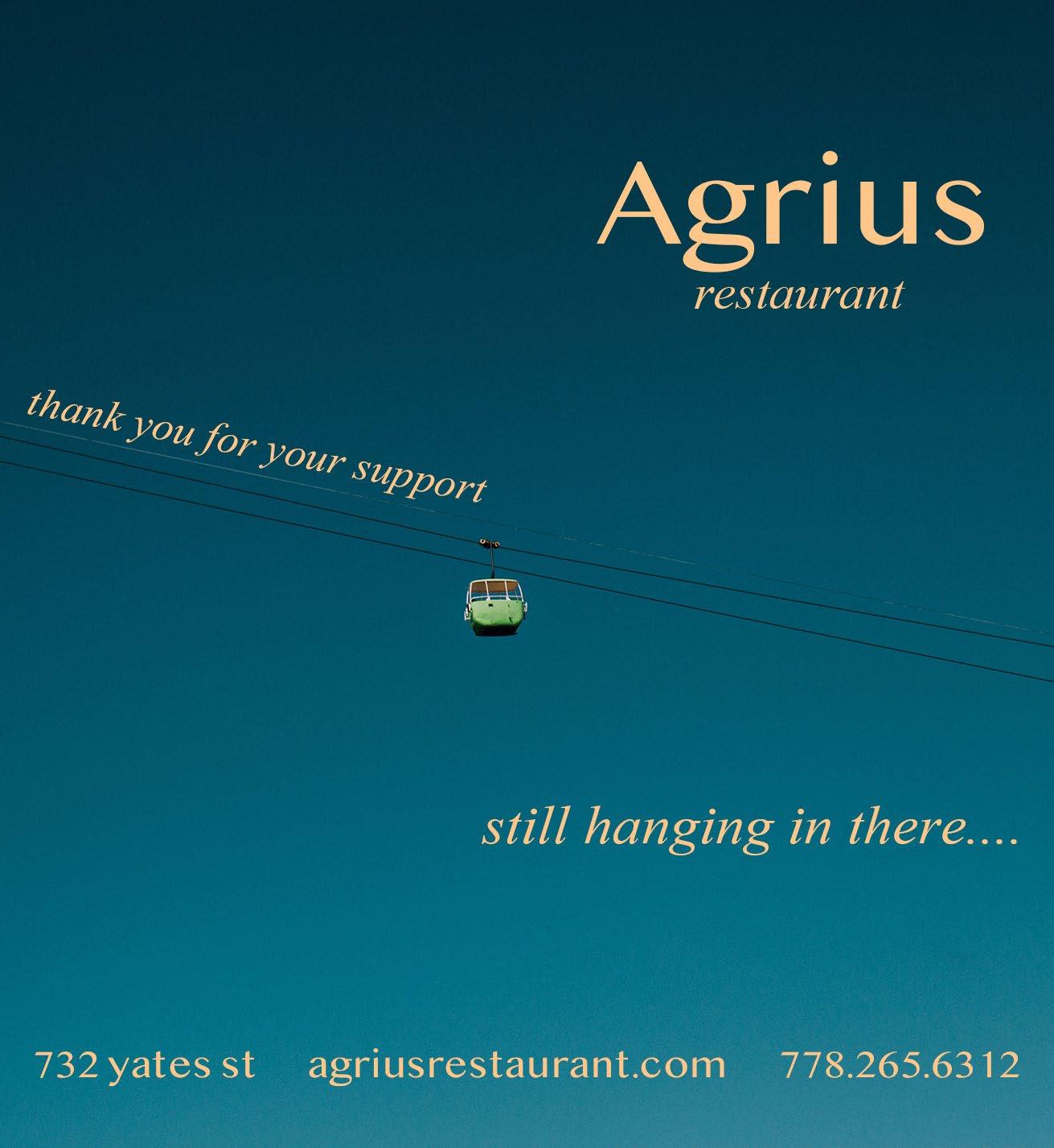
Let’s talk about Niche Grocerant’s zero-waste meal subscriptions. Ceri and Jami want to offer meals that cater to various allergies and dietary needs, and also to parents who want their kids to eat healthy but are time-crunched to explore lunch options. Meal subscriptions have soared in popularity, but the plastic waste is brutal. In their exploration of sustainable materials, Niche Grocerant is flying pretty old school with glass, metal, and other zero-waste components.

The two have been in the local culinary scene for years. Jami spent the last 14 years with Spinnakers, one of Victoria’s original locally focused businesses. Before that, she was GM for Tesiko Enterprises, overseeing a three-room conference centre, café, pub, lounge, and liquor store located in a busy Victoria hotel. Exuberant and expert, Jami leads Niche Grocerant’s financial management and marketing as well as management of the store. Ceri Barlow spent most of her life serving in restaurants, with the last decade seeing her running Vintage Spirits at the Hotel Rialto, wine repping, and as vice-president of the ICC, working with multiple local farmers and food producers and executing large-scale events. With her sales and restaurant experience, the illustrious Ceri leads customer, staff management, and supplier relations. Andrea Duncan will be in the kitchen with her beloved Rational combi oven, creating seasonal “plats du jour.”

When asked whether the concept preceded the desire to collaborate, or if it was the other way around, Jami and Ceri look at each other, beaming, “It was both.” As residents in the Broadmead area, they both saw the gap, but they also were ready to bring their skills and networks together to create something meaningful, not just for them, but for their industry and neighbours. Jami and Ceri chose the name “Niche” because they are serving a niche market and also because they’ve found their own niches within this new venture.
As we finish up our meal, dogs racing about, Lily still barking her face off, something strikes me—only parents could focus on an interview through that din. Ceri, Jami, and Andrea are serious pros with serious chops, and also all moms to medium-to-grown kids. This powerful combination provides a solid foundation for authenticity, excellence, and a remarkable ability to laugh off the small stuff and focus on the meat of the matter. I can’t wait.
GILLIE EASDON
 L to R: Niche Grocerant owners Jami Wood and Ceri Barlow, and chef Andrea Duncan
L to R: Niche Grocerant owners Jami Wood and Ceri Barlow, and chef Andrea Duncan
15
JACQUELINE DOWNEY
Two for One
This partnership pairs recipes from friends
Jennifer Danter and Rebecca Wellman collaborating on a two-for-one idea.
RECIPE + STYLING
Jennifer Danter
Rebecca Wellman
PHOTOGRAPHY
Jacqueline Downey
Rebecca Wellman
As I was writing this back in December of 2020, we were still at a fairly strict level of lockdown here in B.C. For many of us, cooking is a form of comfort, now more so than ever, and just because our bubbles are limited doesn’t mean we don’t want to cook roasts and stews and big pots of soup. This means one thing—leftovers. I love that the progressive dinner party of today means making more than one delicious meal out of the same shopping list. My friend and recipe genius, Jenn Danter, roasts a leg of lamb to perfection and adds a spin on a vegetable side dish. I take the leftover lamb roast and all its trimmings and spin them into two new recipes. One for feasting. One for snacking.
REBECCA WELLMAN
Jennifer Danter’s
Lemony Dill Leg of Lamb
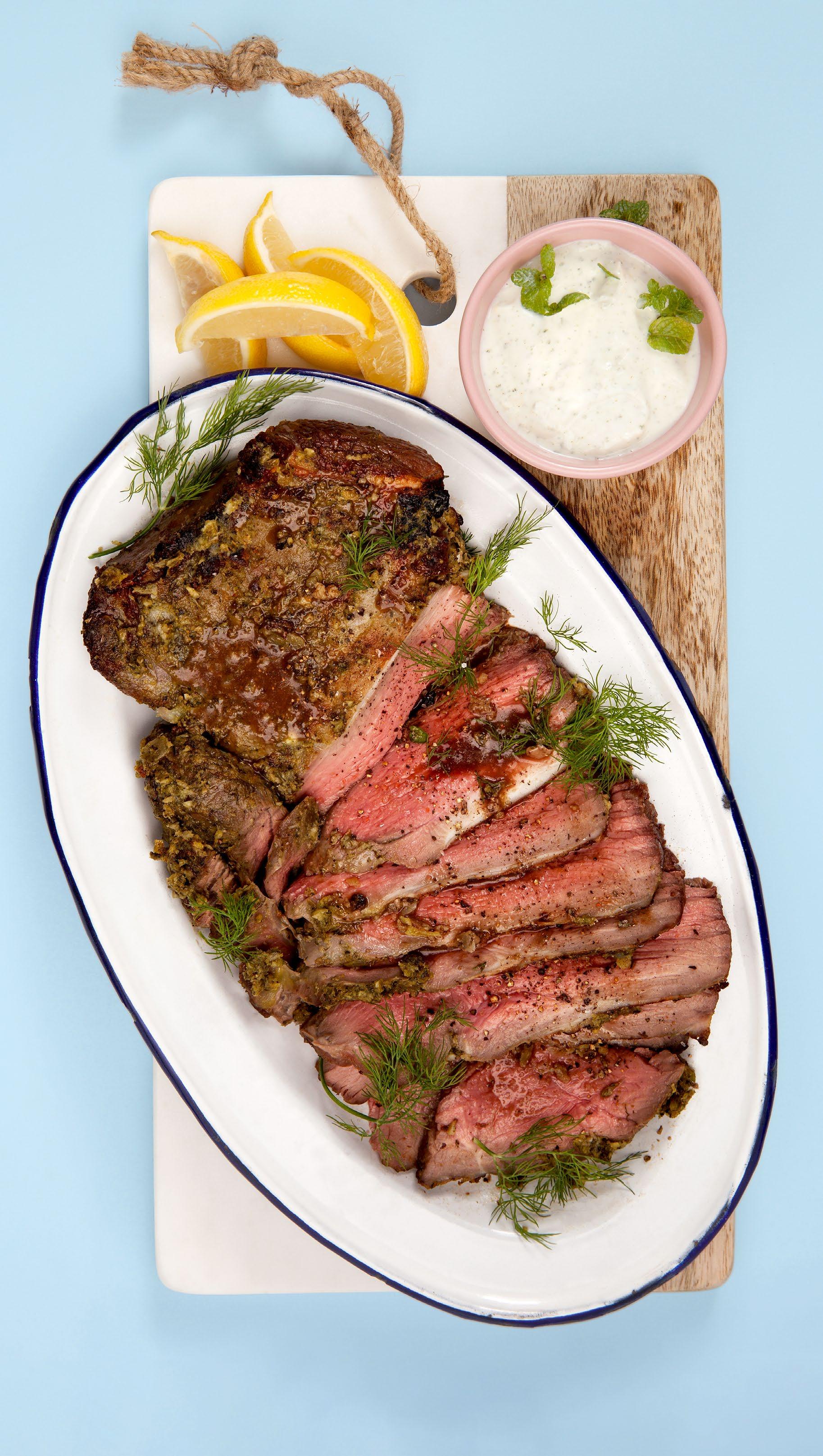
Depending on the weather, you may want to fire up the grill or keep it cozy and roast inside. Makes enough for at least 6 servings as a whole roast, or 4 people plus juicy leftovers to transform into another meal.
¼ cup olive oil
¼ cup chopped fresh dill
4 garlic cloves, smashed
1 small lemon, zest and juice
1 shallot, coarsely chopped
1 Tbsp each dried oregano and dried basil leaves
½ tsp each kosher salt and freshly ground black pepper
2½ lb (1.13 kg) boneless leg of lamb
JACQUELINE
DOWNEY
16 FEBRUARY/MARCH 2021
Lemony Dill Leg of Lamb with Minty Lemon Garlic Sauce
In a small blender, puree oil, dill, garlic, lemon zest and juice, shallot, oregano, basil, and dill.
Lightly score meat-side in a diamond pattern. Place lamb meat-side up in a baking dish. Pour half the marinade overtop; massage to rub in. Flip over and rub in remaining marinade. Cover and refrigerate at least 4 hours or overnight.
When ready to cook, bring to room temperature and follow directions for oven roasting or grilling.
OVEN
Preheat oven to 425°F.
Place lamb on a large rimmed baking sheet. Roast in centre of preheated oven for 30-35 minutes, or until an instant-read thermometer inserted in the thickest part of the meat reads 140°F for medium-rare or 155°F for medium.
GRILL
Preheat barbecue to medium-high heat. Ensure grate is well oiled. Add lamb; sear 3 minutes per side. Reduce heat to medium; grill, flipping meat occasionally,
until lightly charred, about 10-15 minutes, or until an instant-read thermometer inserted in the thickest part of meat reads 140°F for medium-rare or 155°F for medium.
Remove lamb to a cutting board and let rest at least 15 minutes before slicing. Remember, lamb will continue to cook during this time. Excellent with Minty Lemon Yogurt Sauce
Minty Lemon Yogurt Sauce
This recipe makes a lot of sauce, but you’ll need leftovers to make Warm Lentil Salad with Lamb (pg 18).
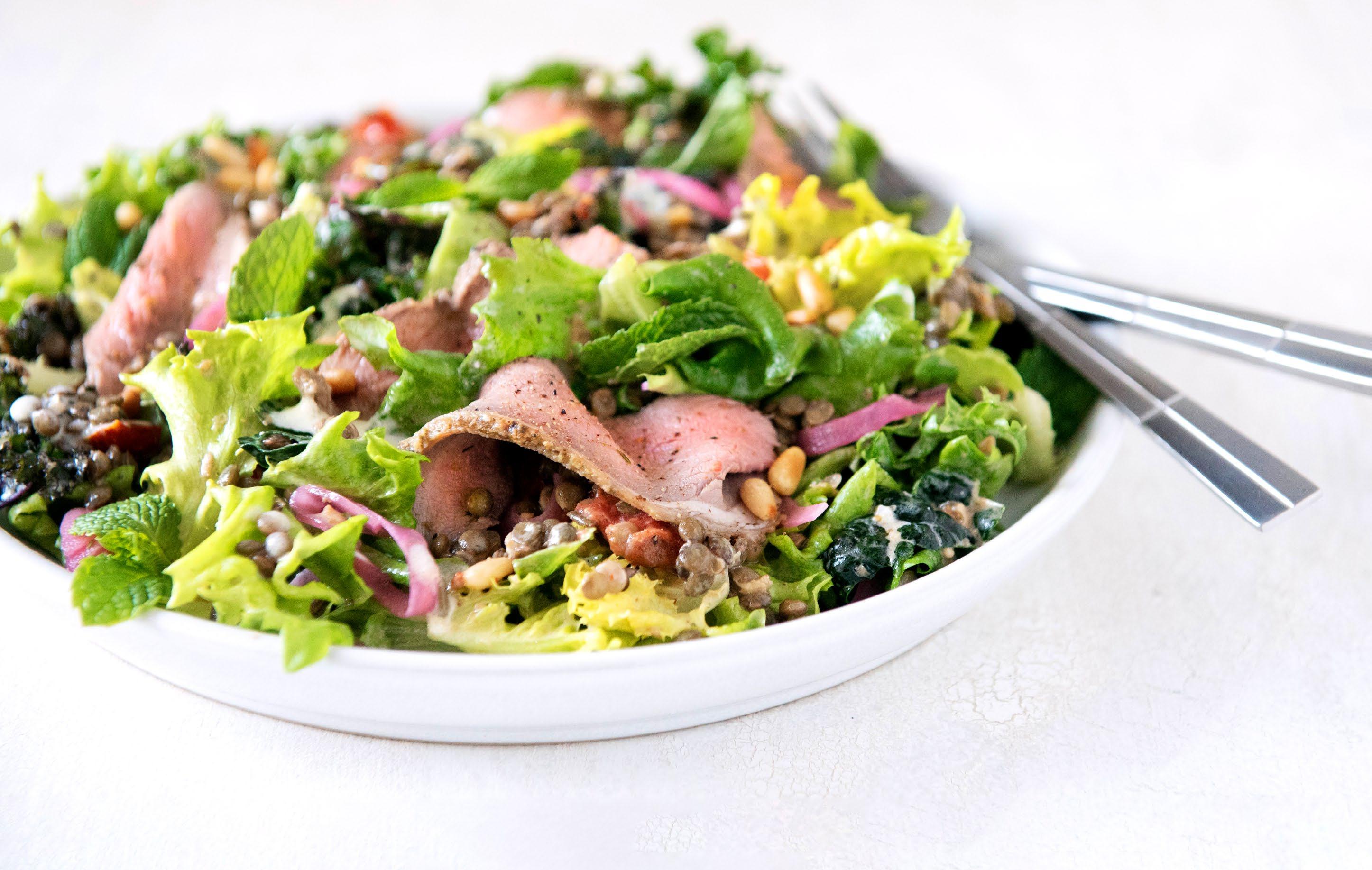
2 cups Skyr or Greek yogurt
1 lemon
1-2 garlic cloves, grated
1 tsp honey
Sea salt and pepper, to taste
1 cup mint leaves
Measure yogurt into a medium bowl. Zest lemon peel and add. Cut lemon in half; squeeze in juice from one
half (refrigerate remaining half for another day). Stir in garlic, honey, salt, and pepper.
Measure ½ cup of your mixture into a blender; add mint. Puree just until mixed. Stir it back into bowl of remaining yogurt mixture. Taste and adjust seasoning, as needed. Sauce will keep well, refrigerated, up to 1 week.
Golden Cauliflower Steaks with Chickpeas
Be sure to hold back about 2 cups worth of this recipe (when chopped), if you can, to make the best Cauliflower Chickpea Hummus (pg 19) ever!
⅓ cup olive oil
1½ Tbsp garam masala
1 tsp kosher salt
½ tsp ground cumin
½ tsp onion powder
½ tsp turmeric
Freshly ground pepper, to taste
1 large head cauliflower, cut into slices (not florets)
1-398 mL can chickpeas or about 2 cups cooked and dried
REBECCA WELLMAN 17
Warm Lentil Salad with Lamb
Arrange racks in top and bottom third of oven; preheat to 425°F. Line 2 baking sheets with parchment paper. In a large wide bowl, stir together oil, garam masala, salt, cumin, onion powder, turmeric, and pepper.
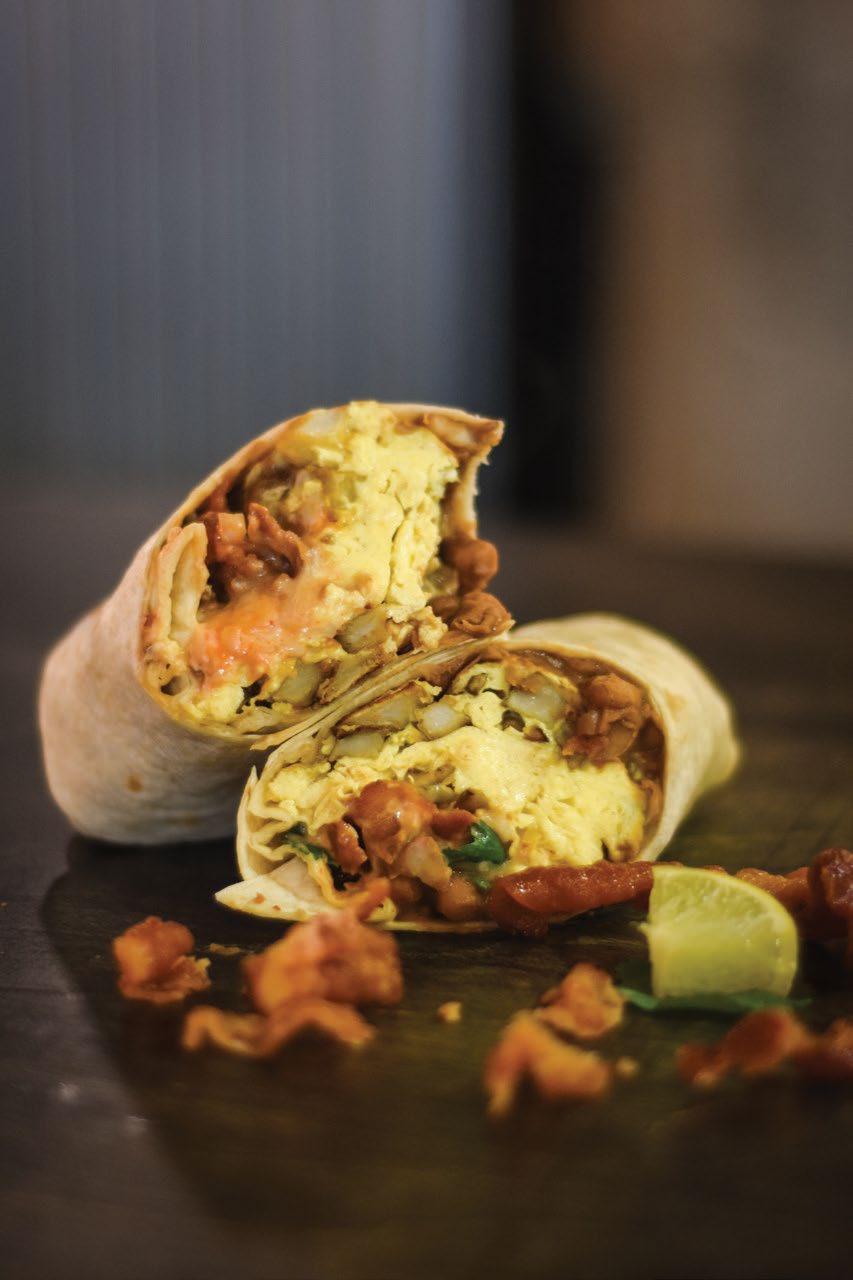
Trim off bottom of cauliflower stem but keep core intact. Cut cauliflower into ½ inch thick slices; it’s OK if some of the florets break off. Arrange large slices only in a single layer between both pans. Brush both sides with some of the curry mixture. Place broken florets in bowl and add chickpeas; toss to evenly coat with remaining curry mixture. Place on sheet, filling the gaps between the cauliflower.
Roast until cauliflower is crispy around edges and chickpeas are browned, 25-30 minutes.

Spoon onto plates and enjoy!
Rebecca Wellman’s Warm Lentil Salad with Lamb
Serves 4.
1 cup French lentils (du Puy), rinsed
1 bay leaf
1 cup halved cherry tomatoes
1½ tsp ground cumin
½ tsp salt
1 Tbsp olive oil
½ cup Minty Lemon Yogurt Sauce (pg 17)
2 tsp Dijon mustard
2 Tbsp lemon juice
½ cup olive oil

6 cups mixed greens, such as kale, chard, spinach or romaine, torn into bite-sized pieces
½ cup mint leaves, thinly sliced
6 oz feta cheese, crumbled
¼ cup toasted pine nuts
Pickled red onions to taste (see note)
Leftover lamb at room temperature, thinly sliced
Heat the oven to 425°F and line a sheet pan with parchment paper.

Place the lentils and the bay leaf in a large pot and add 4 cups of water. Bring to a boil, then lower the heat to a strong simmer, and cook until lentils are tender but not mushy, about 20 minutes.
Toss the tomatoes with the cumin, salt, and olive oil. Pour out on to the prepared sheet pan and roast until slightly browned and cooked, about 20 minutes.
In a medium-sized bowl, whisk together the Minty Lemon Yogurt Sauce, Dijon mustard, lemon juice, and olive oil. Taste and season with salt and pepper if needed.
810 Catherine Street inside the Victoria Market Garden rhubarbdesigns.com · 250.538.8723 rhubarb too UNCOMMON GOODS 250-818-6489 | contact@marilynball.ca marilynball.ca I’ve Got the Kitchen You’ve Always Wanted!
Golden Cauliflour Steaks with Chickpeas
18 FEBRUARY/MARCH 2021
JACQUELINE DOWNEY
Drain the lentils well. Return the lentils to the pot, and set over low heat. Warm them through and ensure all of the moisture has evaporated.
Transfer the lentils to a large mixing bowl. Add the tomatoes and the greens (add the hardier greens first, followed by any more delicate leaves), tossing to slightly wilt. Add half of the yogurt dressing. Toss in the mint leaves, the feta, the pine nuts, and the onions. Toss everything together well and season with salt and pepper if needed.
Transfer salad to a serving platter and top with lamb. Drizzle with remaining dressing. Serve immediately.
Note: Cut a small red onion in half, from root to tip. Slice each half very thin, preferably with a mandolin. Tuck into a mason jar and top with white vinegar, salt and freshly ground pepper.Keep a good supply in the fridge at all times.
Cauliflower Chickpea Hummus

I know, I know. Hummus does not contain cauliflower. However, this mixture is so creamy and tasty and lemony, that it does conjure up pleasant thoughts of the traditional chickpea, tahini, lemon, and garlic combination. So, with full acknowledgement that I am straying from tradition, I call it hummus, only because I prefer that over the word “dip.”
As with every recipe, the addition of lemon juice can be a moving measurement, as lemons vary in sweetness and acidity from one to the next. Much the same can be said for salt, and the addition of salt in this recipe will depend on how salty the original roasted cauliflower is. What I’m trying to say is – blend and taste, blend and taste, and adjust with lemon juice or salt as desired.
2 cups leftover cauli-chickpea mix
1 clove garlic, roughly chopped
1 cup canned chickpeas, drained and rinsed (You can reserve the chickpea liquid—aquafaba—to use in the Chai Vegan Chocolate Mousse recipe on page 26)
4-6 Tbsp lemon juice
1 Tbsp tahini
1 tsp ground cumin
1 tsp salt, more or less to taste
¾ cup olive oil, plus more for drizzling

1 Tbsp toasted pine nuts
½ tsp sumac (optional)
Toasted pita or tortilla chips to serve
Add cauliflower mixture, garlic, chickpeas, lemon juice, tahini, cumin, salt, and olive oil to a large food processor and blend until very smooth and creamy, 2-3 minutes. Scrape into a serving bowl and top with a drizzle of olive oil, pine nuts, and the sumac, if using.
Serve with toasted pita bread or crispy tortilla chips.
REBECCA WELLMAN 19
Cauliflower Chickpea Hummus
Lucky Charms
Cooking up a little much-needed luck.
Cinda Chavich
With 2020 officially in the rear-view mirror, we’re all hoping the coming year will be better—a lot better.
Things are looking hopeful on both the pandemic and political fronts, but as people have known for millennia, it never hurts to grease the wheels when you’re staring down an uncertain future.
And that’s why there’s a long tradition around the world of cooking up a little luck—creating dishes and eating foods that promise auspicious, happy, and healthy days ahead. It’s customary to look forward with hope as seasons change, the dark days of winter giving way to increased sunlight and the promise of new growth and fresh spring flavours.
And whatever calendar you follow, a new year is welcomed with celebrations and menus to match. Many of these foods are symbolic—long noodles for long life, golden bites that represent coins and future wealth, dishes decorated with religious icons or ancient images and filled with lucky charms.
My grandmother made chesnitsa, a baklava-like dessert with honey and walnuts, and hid a silver Canadian dollar in among the flakey layers of handpulled strudel pastry, with the person finding the coin promised a lucky future.
The idea of hiding a coin or a trinket in a dish to bring good fortune, especially in a cake or other dessert, crosses cultures. There’s the little plastic baby (representing the infant Jesus) that’s found in the New Orleans King Cake made for Mardi Gras (this year on February 16), a twisted ring of rich pastry filled with cream that’s eaten as part of the final culinary blowout before the fasting season of Lent. It’s a tradition that dates to Roman times.
In France, the person who finds a bean hidden among the puff pastry and frangipane of their piece of galette des rois is proclaimed king for a day. In Sweden, an almond buried in rice pudding portends the happiness of marriage in the coming year. And the Irish bake barmbrack, a fruit cake with trinkets hidden inside to foretell the future (a ring for marriage, button for bachelor, thimble for spinster, bean for poverty, coin for wealth).

Spring also promises fresh wild ingredients and new crops, so green foods are often on auspicious menus.
Sometimes lucky foods point to hard work and stability, cooperation and sharing, or warding off some potential evil. Though many are associated with religious holidays, they can often be traced further back to pagan rituals, ancient mythology, and folklore.

Hot cross buns are served in Christian communities on Good Friday to symbolize the crucifixion, but the tradition goes back even earlier, to spring festivals celebrating Eostre, the German goddess of fertility and namesake of the Easter holiday. The four quarters of the bun represent the phases of the moon.
There’s often a focus on sweets to usher in a new season. For Rosh Hashanah, the Jewish New Year in the Hebrew calendar (September 6, 2021), honey, apples, and other sweet foods symbolize a sweet year of blessings, with a spiced apple and honey cake on holiday tables. In Japan, there’s a seasonal tradition of pounding rice for mochi, a sweet snack that’s often filled with red bean paste and dyed cherry blossom pink to celebrate spring.
For Nowruz or Persian New Year, a two-week celebration that begins with the spring equinox on March 20, 2021, a crusty rice cake called sabzi polo is served, filled with lots of fresh green herbs (mint, dill, parsley, cilantro, and chives) to represent spring renewal. You’ll also find fish and seven symbolic foods— sprouted wheatgrass, the dried fruit of the oleaster tree, apples, sumac, vinegar, garlic, and samanu, a sweet pudding made with wheat germ—all on the table. And, then there’s the “luck o’ the Irish” celebrations of St. Patrick in March, with their shamrocks representing the rebirth of spring. That’s an ongoing theme in lucky dishes wherever they’re rooted— wishes for prosperity, bounty and wealth.
That’s a big focus among the dishes served during the 16-day Chinese New Year celebrations (beginning February 12 this year). Big banquets are filled with whole fish, golden spring rolls, and mandarins to “bring wealth and treasure.” Dumplings are created and consumed by Chinese families because they resemble the silvery ingots used as currency in imperial China. It helps that the dumplings, plump with lots of cabbage, daikon and pork, are also delicious. It’s been a rough year and with life still feeling chaotic and uncertain, we could all use a little more luck in 2021. So here’s a taste of some of the foods to enjoy for your future health and happiness.
WORDS
PHOTOS: ISTOCK.COM/YOK46233042, ISTOCK.COM/AYGULBULTE, ISTOCK.COM/RUS32
…there’s a long tradition around the world of cooking up a little luck—creating dishes and eating foods that promise auspicious, happy, and healthy days ahead.
Galette des rois with a golden paper crown and one small porcelain charm inside
20 FEBRUARY/MARCH 2021
Colourful mochi dessert
FISH
Fish only swim forward, so many cultures see fish as a lucky food, moving positively into the future. Silvery pickled herring are eaten in Poland and Scandinavia for luck. A whole fish signals good fortune in Chinese culture because the word for “fish” sounds like “abundance.” Whole stuffed fish is also on the Persian Nowruz menu. So steam a whole fish with ginger and green onions to bring good fortune.
PORK
In many countries, from Spain and Hungary to Cuba and China, pork is considered a lucky food, representing both wealth and progress. That’s because a single pig provides a lot of food for a family, but also because it “roots forward” into the future. Austrians give marzipan pigs as lucky charms, and it’s why we save for a rainy day in piggy banks.
BEANS AND GREENS
The tradition of eating Hoppin’ John (black-eyed peas and greens) is all about the money—the collard greens represent greenbacks and the beans swell as they cook, a sign of growing prosperity. Make this classic Southern dish, or cook your beans and greens in a hearty minestrone soup.
NOODLES
Slurping long noodles is said to offer good luck for a long life in China and other Asian countries. Noodles also represent continuity and promise a year where everything will go smoothly. So serve a big bowl
of miso ramen soup or your favourite noodle bowl. The longer the better, but never cut your noodles—that brings very bad luck!
LENTILS
Italians eat green lentils to bring prosperity, a tradition that goes all the way back to ancient Rome. Lentils are round, representing coins, and are often cooked with lucky pork, especially pig’s feet, zampone sausage or a big cotechino sausage. A hearty lentil and sausage soup, with pasta and Parmesan, makes a lucky mid-winter meal, too.
RICE
In Scandinavian countries it’s traditional to serve rice pudding for a prosperous year. But rice is considered lucky in other cultures, too, so make a pudding or a stir-fry for good vibes.


FRUIT



It’s said that the seeds of a sweet pomegranate represent fertility, beauty, and regeneration, plus wealth and good luck, perhaps due to their resemblance to rubies. It’s also traditional to include it in Rosh Hashanah dishes. Try a spring greens salad with a tart pomegranate molasses dressing and glistening rubyred arils on top.
Consuming a dozen grapes is said to bring 12 sweet months—a tradition in Spanish-speaking countries. Other round fruits, especially golden mandarins, which resemble coins, and lucky red watermelons, are auspicious, too. A grape, orange, and watermelon salad drizzled with honey and topped with pomegranate seeds makes a charmed combination.
MOCHI
A Japanese soup to insure a long life is ozoni, a clear dashi broth filled with vegetables, chicken, or seafood, along with the star ingredient, a square or round of rice cake (mochi) that’s grilled or toasted. Because it’s glutinous and stretchy, mochi is a food that represents longevity.
21
Dumplings are lucky for Chinese New Year
Cold Weather Comfort Masterclass
It’s no surprise global pasta sales surged during the pandemic. Pasta is comforting, inexpensive, and pairs well with most ingredients. In an uncertain world, we could all use a little pasta comfort now and then.
In this vegetarian recipe, pasta is stuffed with kale, sweet peppers, feta cheese, and marinated artichoke hearts. An intensely flavoured dish, the pasta is topped with fresh mozzarella and baked in a roasted pepper tomato sauce flecked with briny olives.
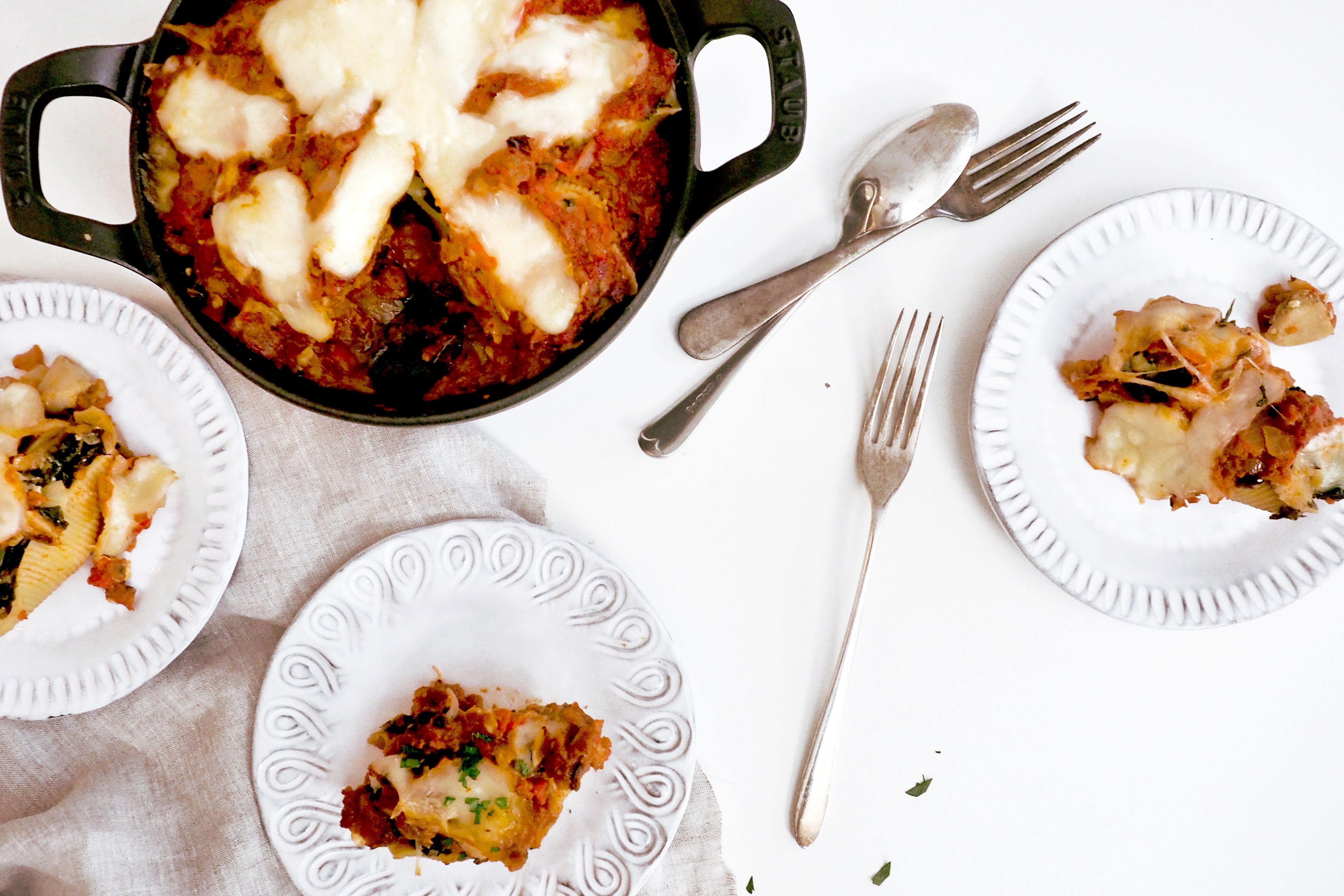
The dish includes an entire bunch of kale, an excellent source of vitamins (K, A, and C) and enough antioxidants to overlook the carbs. Kale is a
heart-healthy vegetable that’s good for your immune system, especially valuable during a lingering pandemic. Pan-frying tames kale’s assertive flavour and the brief cooking does not drain all its nutrients.
If you can’t find jumbo pasta shells, manicotti or cannelloni tubes are a nice alternative, but pasta shells are easier to fill. The pasta is cooked al dente, tender but with a bite. I thought I understood al dente until I travelled to Italy. Pasta there was much firmer than I anticipated. North Americans are accustomed to overcooking pasta, but it has a more satisfying “mouth feel” or texture with some resistance, especially when properly seasoned.
Which brings me to salt. Pasta water should be generously salted—that’s about two tablespoons of kosher salt (4 teaspoons of table salt) per gallon of water. Pasta is relatively bland, and the salt seasons the pasta throughout, making it much more flavourful. Be sure to reserve a cup of the pasta water before draining the pot. The starchy water thins the sauce, but more important, it helps the sauce cling to the pasta. (Try adding reserved pasta water to all your favourite sauces—from pesto to bolognese sauce—it makes such a difference to the outcome of your dish.)
If you were taught (as I was) to add oil to the pasta water to prevent it from sticking together, it’s time to
RECIPE + TEXT Denise Marchessault
STYLING + PHOTOGRAPHY Deb Garlick
22 FEBRUARY/MARCH 2021
Pasta’s enduring comfort in a changed world.
Kale, artichoke hearts and feta cheese make for a nutritious robust pasta filling

re-think this habit. Oil makes the sauce slide off the pasta—exactly what you don’t want! If you use a large enough pot to boil the water, you needn’t worry about the pasta sticking together.
I’ve used fresh mozzarella cheese in this recipe, a moist mild cheese unlike the packages of pre-shredded mozzarella you find at the grocer. Fresh is more expensive than aged, but I enjoy its subtle flavour. I especially love Natural Pastures Mozzarella di Bufala, a delicate and rich cheese made in the Cowichan Valley from water buffalo milk. Fresh cheese has a limited refrigerator life, but in our house, we have no problem using it up.
You could use a commercial sauce for this recipe, but homemade is much more flavourful. Made with roasted peppers, tinned tomatoes, and a handful of olives, this sauce comes together easily.
If you’re seeking a little comfort this season, it’s only a pasta dish away.
Kale-Stuffed Pasta Shells

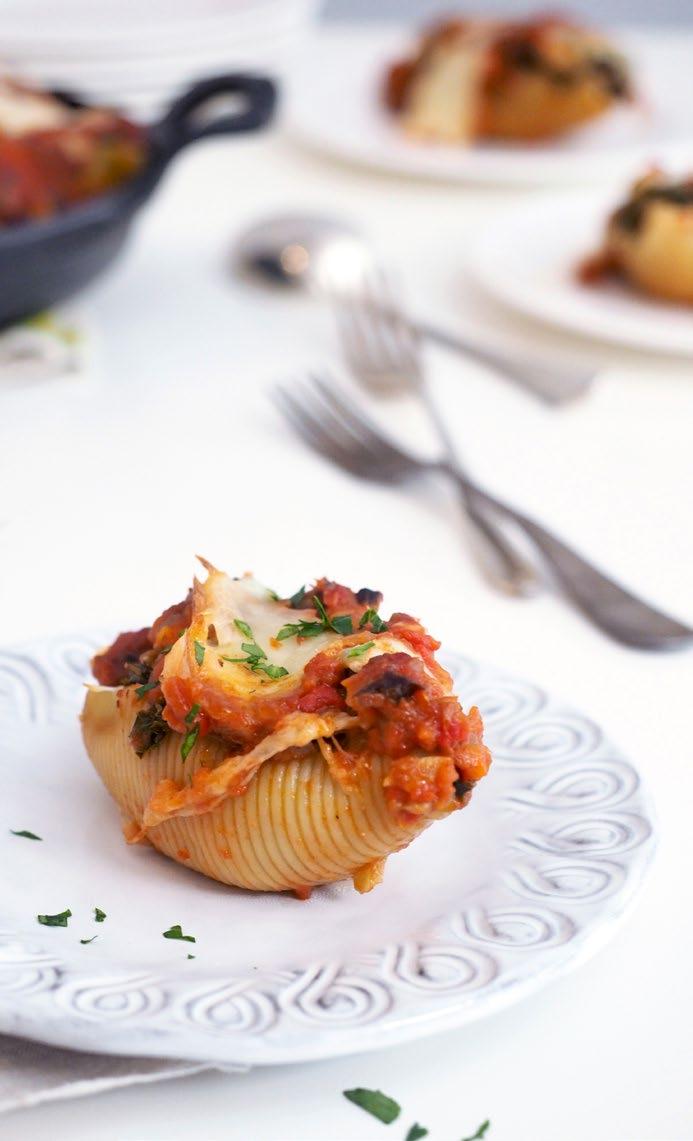
Makes 14-16 pasta shells
Serves three to four as a main dish.
You’ll have more sauce than needed, but you’ll be happy to have extra on hand to freeze or use with your next batch of pasta.
after each batch has reduced slightly. Add the garlic, and stir for about 20 seconds, just until fragrant. Transfer to a medium bowl and add the salt, chili flakes, lemon juice, feta, and artichoke hearts. Mix well and taste. Season with additional salt or lemon if desired. Set aside to cool.
Roasted Red Pepper Tomato Sauce
Makes about 5 cups.
2 medium red bell peppers
2 Tbsp vegetable oil (such as grapeseed) or extra virgin olive oil
2 cups roughly chopped onions, about 2 medium
3 large cloves of garlic, sliced 28 oz (796 mL) plum tomatoes
¼ cup chopped, pitted green olives
⅓ cup chopped, pitted kalamata olives
1 tsp anchovy paste, optional ½ tsp sugar
½ tsp kosher salt
Place the whole peppers on a parchment or foil-lined baking sheet. Bake in a preheated 375°F (190°C) oven until the peppers have darkened in spots and started to collapse, 40-55 minutes, rotating the pan once during baking. Transfer to a bowl, cover with foil. When cool enough to handle, remove the skin, core and stem, and roughly chop the pepper.
Heat the oil in a deep skillet saucepan and cook onions over medium heat until golden, about 5 minutes. Add the garlic, stir for about 20 seconds until fragrant, then add tomatoes, breaking them up with a wooden spoon. Add the roasted pepper and remaining ingredients and stir to combine. Simmer over low heat 10 minutes until the sauce has reduced slightly (you don’t want a thin watery sauce).
When the sauce has cooled enough so that you don’t burn yourself, transfer to a food processor, or blender, and process briefly—you want to retain some texture. Taste and season with additional salt if desired.
Pasta Shells
14-16 jumbo pasta shells
250 g mozzarella cheese, preferably fresh, sliced about ¼ inch thick
Preheat oven 350°F.
Roasted peppers, tinned tomatoes, briny olives and a hint of anchovy paste create a flavourful sauce

3 Tbsp vegetable oil (such as grapeseed) or extra virgin olive oil
1 cup minced shallots, about 2 large
1 cup diced red pepper, about 1 medium chopped kale (stems removed), about 1 bunch
2 tsp finely chopped garlic
½ tsp dried chili flakes
2 tsp freshly squeezed lemon juice
3 oz feta, about ½ cup crumbled
1 cup finely chopped marinated artichoke hearts; remove tough leaves before
Heat the oil in a large skillet and cook shallots over medium-low heat until golden, about 5 minutes, stirring occasionally to prevent burning. Add the diced red pepper and mix to combine. Add the kale, a handful at a time, adding more
Bring a large saucepan of salted water (2 Tbsp kosher salt per gallon water) to a roaring boil. Add the pasta shells and cook according to the instructions, being mindful to cook just until al dente, tender but firm to the bite. Test a shell to determine its doneness. Drain the pasta in a colander and rinse with cool water to cool the shells to prevent the pasta from cooking further.
Putting it all together:
Ladle about 1 cup of the pasta sauce into a baking dish. Stuff each cooled shell with about 2 heaping tablespoons of the filling. Place the stuffed shells, facing up, in the baking dish in a single layer. Cover with about 1 cup of sauce, or more as desired. Place the mozzarella slices on top.
Tent the baking dish with foil and bake for about 25 minutes or until the filling has warmed and the cheese has melted.
Serve immediately.
The ultimate comfort dish
Stuffed
pasta can be served as a main dish or a starter
23
A New Victory Garden
Tackling food security for the Kwakwaka’wakw of northern Vancouver Island one garden box at a time.



WORDS
Mara Jernigan
Everyone’s world changed when Covid-19 hit last March. Little did we know we would spend the coming year testing our entire society and all of its systems, from health care and transportation to food security. The early days were scary. For me, trips to the grocery store were both fascinating and stressful, from the flour and yeast shortages to the steep increases in prices of imported produce, food security was suddenly on everyone’s mind. As the weeks passed, I was grateful to observe all the food production in my own community on Southern Vancouver Island. Farmers’ markets began to cautiously open, everyone was gardening, and new public spaces were being planted with food, including a City of Victoria program to grow seedlings in the nurseries of Beacon Hill Park and distribute potted edible starts for free to anyone who wanted them.
Further north, it wasn’t so easy, especially for indigenous communities. With many of the homelands located at the end of supply chain routes now affected by travel restrictions, these communities were worried, especially about their elders. In April, I became involved remotely in the Nawalakw Healing Society and their project to hire summer students to build garden boxes and place them in the yards of the local ‘Namgis elders in Alert Bay. Their community is located on Cormorant Island, at the gateway to the Broughton Archipelago and a short ferry ride from Port McNeil.
Hailing from Alert Bay, founder and visionary of the Nawalakw Healing Society
K’odi Nelson is a Hereditary Chief and an internationally renowned cultural steward of the Kwakwaka’wakw. He has also worked as an adventure guide, language and culture teacher, dancer, and artist who often designs traditional regalia for potlatches and commissions. He’s a leader counted on by many in his community.
The first weeks of the pandemic were stressful for the ‘Namgis. Alert Bay was one of the first among BC First Nations communities to be hit with Covid cases, suffering the loss of two community members. K’odi’s biggest fear was for the elders. Not only were they relatives, they were Kwak’wala language keepers, and passing on the language to heal, preserve culture, and create new employment opportunities was at the heart of a major new project to re-establish their place in the territories.
Remote communities have unique food security needs. The Nawalakw project to build garden boxes was just one part of a larger food security initiative to support the Kwakwaka’wakw in the remote territories of Gilford and Kingcome, as well as in Alert Bay. Each community had different food needs. Where the hard-to-access Kingcome Inlet was having groceries intermittently flown in, Nawalakw worked with Sea Wolf Adventures to provide safe weekly deliveries for all the families. The people of Gilford Harbour needed protein and wanted wild indigenous foods. So
“Establishing gardens was always on the to-do list of the society, the pandemic just pushed it to the forefront”
– K’ODI NELSON
Stephen Alfred, Dallas Nelson, Jakob Dawson built and delivered over 100 garden boxes.
Harvesting and second planting.
L to R: Eli Cranmer, Effory Sedgemore, Giselle Alfred, Danya Harris, Adrienne Dawson
Generations working together.
24 FEBRUARY/MARCH 2021
Clockwise from left: Gwimolas Cranmer Hunt, Angela Brown, Effory Sedgemore, baby Grayson
fishing boats were dispatched to fish for them. The ‘Namgis, living in Alert Bay, were used to shopping at their local grocer Shop Rite, which was now experiencing shortages of fresh produce. K’odi was impressed with a community garden box project he had seen further north in Bella Bella. So he and his son started to build their own boxes and then built more for immediate family members.
“Establishing gardens was always on the to-do list of the society, the pandemic just pushed it to the forefront,” K’odi told me. Building and planting his own garden boxes got him away from the stress of Covid. “I dove into it hard. I read and researched and looked forward to getting up early to get a bit of time in the garden before work. It gave me peace and joy, and made me forget about all the problems of the pandemic for a while.”
When pandemic relief funding came, they hired some of the community’s young men to build cedar boxes, distribute, and fill them with donated topsoil. Before long, more than 100 boxes had been dispersed in yards around the island. I purchased and mailed seeds from Victoria and provided online support with gardening tips. At the end of April, my son Julian and I drove up to Port McNeil to deliver 21 apple trees and rhubarb plants.
Once the initiative launched a Facebook page (see the end of the story for the URL), seeds, tools, and other donations began to come in. By

now, K’odi had brought in Sea Wolf Adventures guide Sherry Moon, who hails from Kingcome Inlet and knows the territory and the waters well. She not only coordinated the garden project in the early days of Covid, she also used the Sea Wolf vessel to do the weekly runs to Kingcome and Gilford since tourism in the region had all but dried up. The careful, masked trips to her homeland to deliver provisions and help her people warmed her heart and kept her going through a year of long days on the water.
“It felt amazing to bring food to the community members in the territories,” Sherry tells me. Until she left as an adult, Sherry spent her life in Kingcome Inlet. “I know what it is like to live remotely. Helping each other, especially in times of need, is just something I have always done, it’s how I was raised, and it filled my heart with joy to help. “
As Sherry spent more time on the water, Alert Bay local Tanis Dawson was hired to co-ordinate the garden box project. A natural mother figure with an infectious laugh, she mobilized not just the students but a variety of people in the community to plant seed starts in trays at home. She co-ordinated the planting and upkeep of all the garden boxes, drove the students around to care for the gardens, and organized to accept seed and plant donations that even included some of the starts from the Beacon Hill Park nursery. She saw the effect on both the elders and the students.
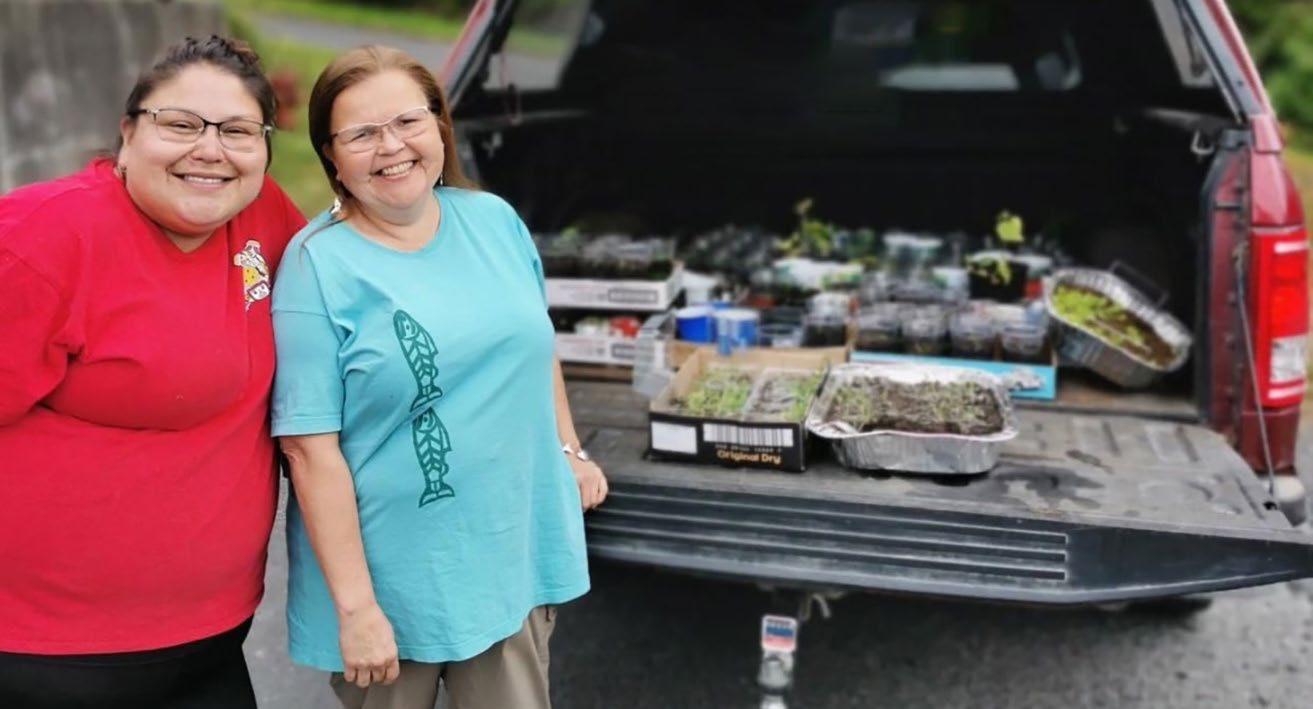
The synergy had unexpected benefits for the health and well-being of all involved. The elders looked forward to the regular visits from the students to water and tend their gardens. A few of the elders started to work in their own garden beds, getting them out in the fresh air and giving them something meaningful to do. However, because many had attended residential schools, a few of the elders associated gardening with forced manual labour and even punishment, unlike the summer students, who did not have these bad memories. Everyone was experiencing new foods and garden-fresh flavours, some for the first time. Tanis found new recipes, working to find ways to use the abundance of things like kale. Everyone loved the kale chips and smoothie pucks, which she and the students made with puréed and frozen kale and berries.
Over the course of the summer and into the fall, the garden boxes produced an abundance of lettuces, tomatoes, squash, beets, and more.
Donated blueberry bushes were a hit and were distributed as far as Kingcome and even some of the young apple trees bore fruit.
While the food security initiative was started in response to Covid, it has taken hold and will continue. The group is planning to build greenhouses and expand the program in the 2021 season. “Our people have endured successive waves of traumatic disruption that have threatened our very existence,” says K’odi. “This is part of a bigger vision to re-establish ourselves in our territory and restore the land, our language, and culture.
In an age of uncertainty, I can’t help but believe they are well equipped to do this.
For more information:
Nawalakw Healing Society, nawalakw com

www facebook com/ nawalakwcultureprojectcovidrelief
Images courtesy of Nawalakw Culture Project Covid Relief.

25
Tanis Dawson (L) and Donna Cranmer (R). Donna supplied hundreds of starters.
Vegan Mousse
Chickpea water (yes, really) subs for eggs in this plant-based treat.
RECIPE + STYLING + PHOTOGRAPHY Isabelle Bulota


Chocolate mousse is a delicacy, and a rich one at that. The traditional recipe features several eggs and lots of butter or cream. Aquafaba, the water in which legumes such as chickpeas are cooked, has the ability to mimic the functional properties of egg whites. This gives this delicious vegan dessert a surprisingly soft texture, and I promise you it doesn’t taste like chickpeas! Aquafaba can be used as a direct substitute for eggs in some cases, such as this lush chocolate mousse. The result is magical, delicious—and completely plant-based.
Chai Vegan Chocolate Mousse

Servings: 4-6
1 cup (250 mL) aquafaba (liquid from a jar or can of chickpeas)

175 g dairy-free high-quality dark chocolate
2 organic Chai tea bags
Garnish options
Coconut whipped cream (dairy-free alternative to traditional whipped cream)
Roasted mixed nuts
Fresh mint
Break the chocolate into small pieces and place in a heat-resistant glass or metal bowl. Place the bowl over a pot filled to a third with water and let the chocolate heat up very slowly, stirring often. Make sure the boiling water does not touch the bottom of the bowl. This is important because chocolate is very sensitive to high temperatures and it could rapidly change texture. Once the chocolate has melted, remove the bowl from the heat and let it cool a little.
Add the aquafaba to a saucepan over medium-high heat. Add the chai tea bags to the saucepan and stir. Let the tea steep in the liquid for about
5 minutes. Do not let it boil. Remove the pan from the heat and transfer the liquid to a large mixing bowl to cool.
Make sure your bowl and electric whisk are clean and grease-free. Whisk the aquafaba until stiff peaks are formed. This should take around 5-7 minutes. You can check the stiffness by turning the bowl carefully sideways; the mixture should not move.
Check that the chocolate has cooled sufficiently. It must not be hot to the touch. Otherwise the chocolate may stick, and you will get a grainy mousse.
Using a silicone spatula, gently and gradually fold the melted chocolate into the whipped aquafaba. Don’t worry if your foamy mixture deflates a little once the chocolate has been added, this is perfectly normal. Scoop the mixture into serving dishes and refrigerate for at least 1 hour or overnight, up to 3 days.
When ready to serve, top with your garnish, and enjoy!

26 FEBRUARY/MARCH 2021








CIBC WOOD GUNDY BLUE HERON ADVISORY GROUP SUSTAINABLE, ENVIRONMENTALLY FRIENDLY INVESTMENT SOLUTIONS SERVED FRESH RIGHT HERE ON VANCOUVER ISLAND. Want to make a difference and still meet your financial goals? Let us show you how using proactive Environmental, Social and Corporate Governance (ESG) standards can do just that. We’ve been doing it for years. Right here in Victoria. Contact us today to learn how we help create more sustainable portfolios. www.blueherongroup.ca 250 361-2284 blueheronadvisorygroup@cibc.ca Neil Chappell and Graham Isenegger are Investment Advisors and Portfolio Managers with the Blue Heron Advisory Group of CIBC Wood Gundy in Victoria BC. CIBC Wood Gundy is a division of CIBC World Markets Inc., a subsidiary of CIBC and a Member of the Canadian Investor Protection Fund and Investment Industry Regulatory Organization of Canada. CIBC Private Wealth Management consists of services provided by CIBC and certain of its subsidiaries, including CIBC Wood Gundy, a division of CIBC World Markets Inc. “CIBC Private Wealth Management” is a registered trademark of CIBC, used under license. “Wood Gundy” is a registered trademark of CIBC World Markets Inc. If you are currently a CIBC Wood Gundy client, please contact your Investment Advisor. Past performance may not be repeated and is not indicative of future results. Breathtaking DINING IN THE SKY OPEN DAILY 600 Ebadora Lane, Malahat, BC | 250.856.0188 | villaeyrie.com @ VillaEyrie Located at the Villa Eyrie Resort, only 15 minutes north of Langford Rated as having one of the best views in all of Canada, enjoy sweeping views overlooking Finlayson Arm and the Olympic Mountains while dining at Alpina Restaurant. Treat yourself to a world-class culinary experience featuring classic European dishes with a modern West Coast twist. 27































GET A TASTE OF THE ISLAND.


















 CYNTHIA ANNETT-HYNES EDITOR
CYNTHIA ANNETT-HYNES EDITOR





















































































 L to R: Niche Grocerant owners Jami Wood and Ceri Barlow, and chef Andrea Duncan
L to R: Niche Grocerant owners Jami Wood and Ceri Barlow, and chef Andrea Duncan



































































